- Newsletter Issue Number:
- AICCM National Newsletter No 161 August 2023
International Conservation Services (ICS) Canberra
Duntroon House stands as one of the oldest homesteads in Canberra, built in 1833, and remains an excellent example of early Australian architecture. The traditional colonial-style house originated as a sheep station and is now a special part of Australian Army heritage.
ICS was commissioned to manage and treat the heritage collection kept at Duntroon during redevelopment works. This included everything from assessment, cleaning, and pest control to storage. This large multi-disciplinary conservation project saw the team treating and cleaning curtains, light fixtures, and stone steps to conducting condition reports of 560 movable heritage objects during pest treatments and storage.
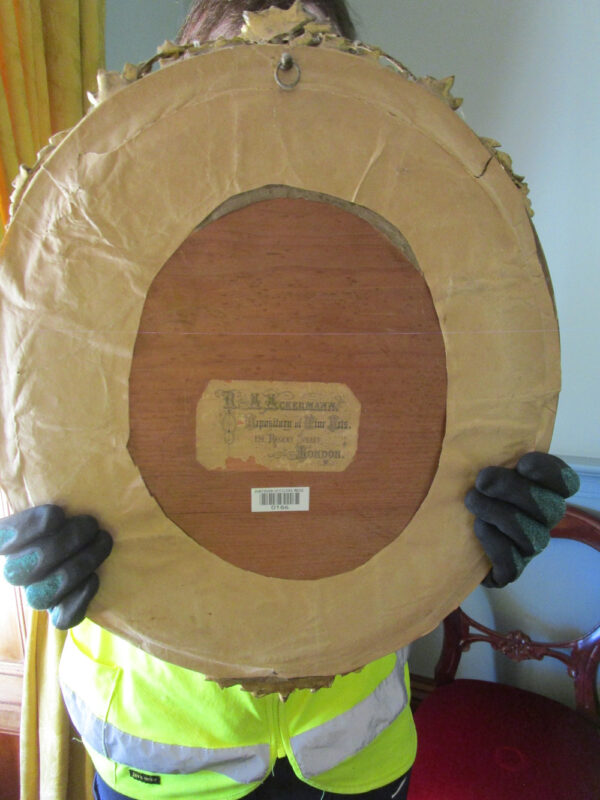
Cataloguing the large heritage collection at Duntroon
National Gallery of Australia (NGA)
Lending
The Loans Coordination staff have been working on the new initiative to share major works from the National Collection. As these are long-term loans the existing lending parameters have been reviewed. They have been working on venue assessments and developing a new approach to risk management for these projects.
Objects
Objects Conservation has been busy preparing artworks for a range of concurrent exhibitions including Deep Inside my Heart and Know My Name: Australian Women Artists travelling exhibition. The team has also been overseeing complex installations of Night and Day by Alexander Calder and the deinstallation of Spice Tower by Montien Booma for the LED lighting project. Courtney Crane has just returned from Auckland where she was condition checking and assisting with the installation of Ever Present. Objects Conservation recently hosted intern Sophie Fairbridge from the University of Melbourne conservation program. The team has welcomed Emily Vearing in the Project Conservator role and is sadly bidding farewell to Alysha Redston who is leaving to take up the Objects and Time-based Media Conservator role at MONA.
Paper
Paper Conservation and Mount Cutting has been busy preparing a large number of works for Know My Name: Making it Modern opening at the beginning of August. So far 160 works have been condition checked and framed. Fiona Kemp has been travelling to condition check and oversee the installation of Warhol and Lichtenstein in Cairns and Ever Present in Auckland. After 26 years at the Gallery, Andrea Wise retired at the beginning of July. Her tenacity and passion will be deeply missed in the lab.
Paintings
Paintings Conservation has been working on Making it Modern, which has included framing a large selection of Clarice Beckett works. They have also been preparing a major loan of First Nations paintings to the Museu de Arte de São Paolo, Brazil. Paintings Conservation has welcomed Janet Hearne to the team while David Wise is on long-service leave. Janet has hit the ground running, preparing paintings for display and loan and squeezing in a couple of treatments.
Preventive
The Preventive Conservation team has been continuing to work closely with Building Services on capital works including advising on the LED lighting project. They have been busy with ongoing anoxic treatments of new acquisitions and the collection, and quarterly pest control of storage areas. Lisa Addison has been monitoring light and UV levels in the TEG foyer to develop new risk assessments for display of artworks in this space and redeveloping conditions of entry for the Gallery.
Textiles
Textile Conservation has been working on a range of 1960s fashion and accessories that will go on display in early August. Carmela Mollica has been working with Kensuke Todo to replicate several missing buttons on a 1960s pink Chanel suit. Michelle Hunter has completed treatment to reshape many crushed flowers on a lily of the valley covered hat by Madame Paulette. Micheline Ford has been preparing textiles for Making it Modern, which has included wet cleaning of a Dorrit Black printed handkerchief. Tiffany Abbott has been making modifications to mannequins and display devices for 1960s fashion and Making it Modern. Over the last several weeks, Textile Conservation has been hosting an intern, Tereza Blahova, from the Textile Conservation program at the University of Glasgow. Tereza has been learning about different wet cleaning techniques on an ulos and has been undertaking humidification of a Peruvian fragment.
National Library of Australia (NLA)
Staffing – there are a lot of updates!
In June we said farewell to Clair Murray who has been with us for two years and we congratulate her on her ongoing role at Canberra Girls Grammar School. We also farewelled Sophie Antulov and Belinda Muir who joined us for short-term contracts this year and we congratulate them on their new roles at the Australian War Memorial and CSIRO, respectively.
We said a fond and temporary farewell to Jennifer Todd as she is on secondment at the National Film and Sound Archive, and Freya Merrell who is on maternity leave. We are delighted to announce she and her husband welcomed a healthy baby girl in April.
We welcome back Lisa Jeong-Reuss who has brought back lots of new experiences from her secondments at the National Museum of Australia and the Australian War Memorial.
In the team we also welcome new staff members Cheralyn Lim, Caroline Milne and Jacinta Sanders.
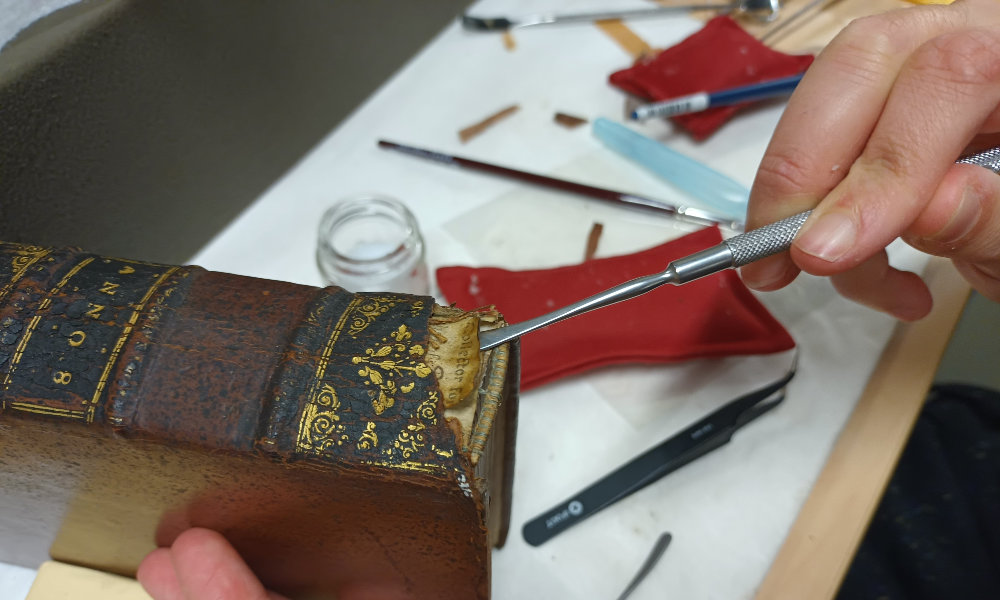
Overseas Rare Book Project stabilisation treatment in progress.
Key achievements
The team has been working across exhibitions, loans, new acquisitions, digitisation, reader support and the prioritised collection treatment programs. In the 2022–2023 financial year we treated and surveyed more than 24,000 items across all of our programs! We have also embarked on a series of projects related to wider NLA works. Some key highlights include:
- Preparing the journal of the H.M.S Endeavour, 1768-1771 for display – it can be seen now in the Treasures Gallery
- Assisting with the relocation of more than 800 hanging artworks due to stack upgrades
- Condition checking and facilitating access to Archipelagus Orientalis, sive Asiaticus (a rare Dutch map by Blaeu)
- Commencing the Overseas Rare Book Project to stabilise 70,000+ volumes in preparation for the movement of the collection
- Cleaning the three Alice Kettle tapestries usually on display in the Main Reading Room
- Supporting our major building infrastructure projects.
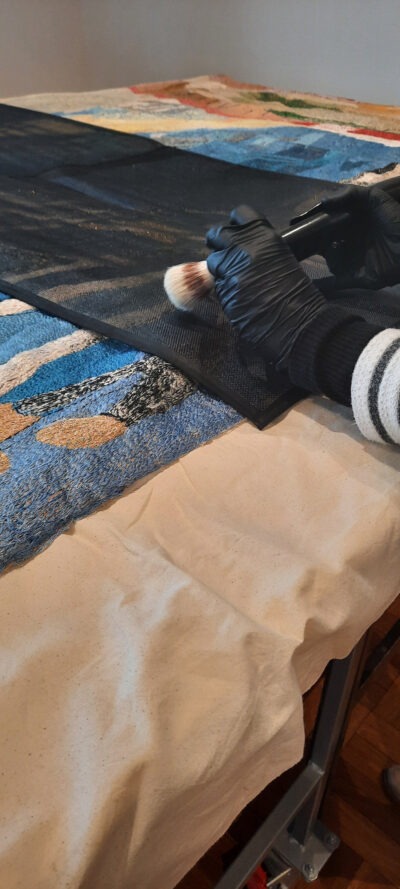
Cleaning of the Alice Kettle tapestries
Art Gallery of New South Wales (AGNSW)
Paper Conservation
The team has recently welcomed intern Rebecca Clendenin from Queens University in Toronto. Rebecca will be working at the Gallery for three months on a range of tasks including processing works for exhibition and loan. The loans program is back up and running after a moratorium, and works are being prepared for loan to institutions including Bendigo Regional Art Gallery and QAG/GOMA. Kate Hughes and Rebecca Clendenin have been treating Thy Kingdom Come by Marikit Santiago, a 1.7 x 3-metre painting on cardboard, for loan. Before commencing treatment, they met with the artist to interview her about how she wanted her work cared for, looking at stabilising vulnerable areas of the work before travel, and long-term care. Lois Waters has been preparing works for the upcoming Brett Whiteley Studio exhibition Chapters 1959–1969, which will examine Brett’s work from this period. Lois has also been busy working on changeovers across the Gallery including the Contemporary Australian and Asian Galleries. Keyeele (Kiki) Lawler Dormer has been continuing work with the photography team on a significant project to digitise the work of women artists in the collection. To date, Kiki has prepared over 670 works for photography, allowing these works to be made available on the AGNSW website, and in turn increase their potential for display, loan and research. She has also been working on the new Library display of artists books, Pandemic Days. Grant Hawkes has completed mounting and housing refresh work on the upcoming exhibition at Brett Whiteley Studio, and finalised the changeover of the Haus Yuriyal oil pastels that are currently on exhibition at the Gallery. He has also prepared Francisco de Goya prints for display and is preparing Honore Daumier prints for upcoming display. He is continuing to mount sizeable new acquisition collections to the Gallery from Jim Masselos, Robert Dein and Gael Newton gifts, alongside various other Australian and International new acquisitions. Grant will also be involved in the upcoming exhibitions and the new Library display. Analiese Treacy has been preparing works for the upcoming Hoda Afshar photography and film exhibition, which will open at the Gallery on 2 September. Analiese has also been working on a group of works from Lismore Regional Gallery as part of a flood recovery and assistance project. The entire paper conservation team worked on the deinstallation of the National 4. Song Cycle by David Sequeira, made up of 340 A4-sized drawings on paper, had been hung using Lascaux sticky dots. This proved to be a very successful display method but required specialist conservation skills to safely deinstall.
Frames Conservation
Genevieve Tobin in collaboration with Selina Halim (from the Paintings team) presented a seminar in July at the AGNSW on ‘Mouldable, Peelable, Semi-Rigid Solvent Gels from xPVAc and Borax: Preparation of Gels and Practical Applications for Cleaning Gilded Objects and Paintings’. As part of this event, Gen and Selina demonstrated the potential of xPVAc-b solvent gels (developed as part of ongoing research into cleaning of gilded surfaces) for the cleaning of gilded frames, paintings and objects. Gen will be presenting a paper on xPVAc-b gels for cleaning gilded frames at ICOM–CC Triennial in Valencia in September, and will soon be leaving the AGNSW to take up a Mellon Fellowship in the Frames Department at the National Gallery of Art (NGA) in Washington DC. This is a wonderful opportunity for Gen, and we wish her all the best in this new role! Barbara (Basia) Dabrowa has recently gone on long-service leave overseas, and during this time will be taking the opportunity to attend the 20th ICOM–CC Triennale Conference in Valencia in September!
Reproduction Framing
Tom Langlands has been working on three frames for the Australian 20th Century galleries. The frames are based on early Sydney modernist Parker frames and have been taken from cues from similar works by the artists in the collection. He has been working with Genevieve Tobin reproducing ornaments for the back edge of the Dicksee frame. Also, an oval display panel was made for a recently acquired Debra Kelly work, and a number of box frames for collection works.
Paintings Conservation
The team welcomed Madelyn Smith, a University of Melbourne student, for three weeks in the lab. Madelyn treated a new acquisition by Valerie Strong as well as helping with various other tasks.
Celine de Courlon has been working with other departments on building works in the North and South Gallery buildings. Celine is working in close liaison with the curators on the exhibition changeovers for both Gallery buildings and has joined the team working on the Biennale 2024. Selina Halim assessed paintings for a collection exhibition that will be presented in the Kaldor Family Hall at the same time as the Kandinsky exhibition. She will start treatment of these paintings shortly. Selina and Andrea Nottage started a major conservation project on Phillips Fox’s Autumn showers. The painting treatment will take eight months to complete. Madeleine Ewing has been busy preparing paintings for a new exhibition at the Brett Whiteley Studio as well as a new hang of the Kaldor Family Hall and taking part in The Nationals 4: Australian Art Now de-installation. Simon Ives is back from a long holiday in Europe and back working on the outward loans program as well as doing various other tasks such as assessing new acquisitions. Melissa Harvey has been busy assisting with all projects, exhibitions, changeovers, and loans. Melissa will manage the stretching of Rodel Tapaya’s work Do you have a rooster, Pedro? (Adda manok mo, Pedro?), a 3 by 7 metre painting that will be displayed in the North Building. The team facilitated a Bruker workshop at the Gallery in May during which several paintings from the collection were analysed with their M6 Jetstream and their Elio.
Objects Conservation
Bronwyn Tulloh recently rallied the objects conservation team to clean and wax the outdoor Yayoi Kusama sculpture together. It went very well until it rained on the team just before they finished! Bronwyn also assisted with changeovers to the 20th century collection displays, including preparation of an installation artwork made of netted onion bags by Lauren Berkowitz. Ash Gilmour is assessing and preparing a variety of works for an exhibition changeover at Brett Whiteley Studio. She has also been travelling recently to condition report and install the Archie 100 touring exhibition, including trips to the Gold Coast and Darwin. Sofia Lo Bianco is currently undertaking the mammoth task of working with our registration and installation teams to deinstall the incredible sculptural installation by Adrian Villar Rojas from the historic oil tank gallery. These huge but fragile works require careful handling, extensive documentation, and conservation treatment. Kasi Albert condition reported and prepared almost 170 ceramics from the AGNSW collection for a new (and very full!) exhibition—brick vase clay cup jug—which was installed recently. Kasi is also currently deinstalling works in The National 4: Australian Art Now, including numerous complex installation works, which have been acquired. All of the objects team has been contributing to work associated with the movement of some large collection works to some new off-site storage. This has included some artworks that have not been displayed or assessed previously, so it has been an interesting opportunity to see some fascinating items and assist with their documentation and photography. The team also said goodbye to French intern Aourelle Cohadon, who returned home after five months at the Gallery.
Time-based Art Conservation
Carolyn Murphy and Juanita Kelly-Mundine are working on the Australian Research Council Linkage project: Precarious Movements: Choreography and the Museum. A new dance commission KŌIWI by Victoria Hunt was recently performed at AGNSW and forms one of the project’s case studies. Read Victoria’s artist interview here: https://www.artgallery.nsw.gov.au/art/watch-listen-read/read/artist-interview-victoria-hunt/
The whole team—TBA Conservators Lisa Mansfield, Emma Ward, and Asli Gunel, and TBA Technician Jonathan Dennis—is researching and developing care plans for collection works based on obsolete tech and/or software. Our deep dive reinforces the need for a holistic approach and collaboration to adequately care for TBA as we seek expertise from AGNSW AV Exhibitions and ICT teams, and external contractors in specialist areas of electronics and software.
We are looking forward to interacting with some stellar 1990s CD-ROM art and archived materials again! Rebecca Barnott-Clement, Lisa Mansfield and Asli Gunel attended disk imaging training, led by Dr Cynde Moya (Swinburne University) for Archiving Australian Media Arts: Towards a method and national collection. The project seeks to develop a best practice method for stabilising and preserving Australian media arts heritage and to investigate approaches to access and exhibition of this heritage. Research has been supported by multiple ARC Linkage and Discovery grants as well as a current LIEF grant to support the expansion of the Australian Emulation Network using the Emulation as a Service Infrastructure (EaaSI) framework.
TBA Conservation is gearing up to work on, and support our AV colleagues with, the Volume festival. Angela Goh and Sam Smith are just two of the fantastic artists presenting new works in the G8 Tank space: https://www.artgallery.nsw.gov.au/whats-on/events/volume/
Exhibition and Loans Conservation
Sarah Bunn has departed the Gallery temporarily to take up a nine-month position at the State Archives in Kingswood. Frances Cumming returns to the exhibition role after work on a major project focusing on the Chinese Art Collection at the Gallery. Frances is currently working with the team on the deinstallation of the Adrian Villa Rojas work in the North Building Tank, and leading preparations for the arrival of the Kandisky exhibition, which will open at the Gallery in early November.
Preventive Conservation
Jessica Gray-Hart has been managing the Gallery’s IPM treatments, both low-temperature and anoxic, for the busy exhibition schedule and influx of new acquisitions. The Gallery’s new Isolcell Nitrogen Generator has made anoxic treatments efficient to run and monitor with automated humidity control and an in-built temperature sensor.
Work is continuing on the development of a new Art Incident reporting system, with a demo version developed and released to other departments for review and feedback.
An intensive environmental monitoring program is being undertaken across the new exhibition building to assess and analyse data trends in the first year of the building being open to the public.
Australian Museum
Collection Care and Conservation
As part of AMAGA 2023, conservators Rehan Scharenguivel and Silvia Da Rocha co-presented a talk with Dr Mariko Smith, Manager First Nations Collections and Engagement, on the theme of ‘discomfort’. Their talk, ‘Not the Colonial Museum?’, spoke on the history of natural history collecting, the harm of historic colonial practices, and what echoes we experience today. The talk sparked a lot of interesting feedback. It was great to see a few conservators at AMAGA!
In June the Museum held a special event to unroll one of the largest ngatu (bark tapa cloth) from Tonga. The ngatu, Ngatu Me’a’ofa, was originally gifted to the Sydney Opera House on its opening in 1973 and was then acquired by the Australian Museum. It was measured on the day at 29 metres long by 16 metres wide. This event gave us the opportunity to undertake a full condition assessment and digitisation of the ngatu. The project was led by Heather Bleechmore, with the help of Melissa Holt, Kyra Kim, and Rehan Scharenguivel, in collaboration with multiple departments across the Museum. Due to the size of the ngatu it had to be transported (using a truck and crane) to the Blacktown Leisure Centre, where it was unrolled over the multiple open basketball courts. It was a huge day and an amazing team effort!
Treatment projects
Sophie Phillips is currently treating a yellow-tailed black cockatoo (Calyptorhynchus funereus), which took a literal nosedive when a wire broke during its re-installation. The specimen’s beak was badly cracked by the impact and the skin on the breast split open. So far, the beak has been stabilised using Paraloid B72 to reattach a section, and Japanese tissue to stabilise cracking and flaking. The open losses have been filled with a modelling paste. The skin on the breast is very dry and brittle and rejoining the two sides is not possible, so Sophie is now working to bridge the large split in the skin using Japanese tissue, with EVA and starch paste. Once this area has been stabilised it will be inpainted and further treatment will be undertaken on the beak to return the specimen to a realistic appearance.
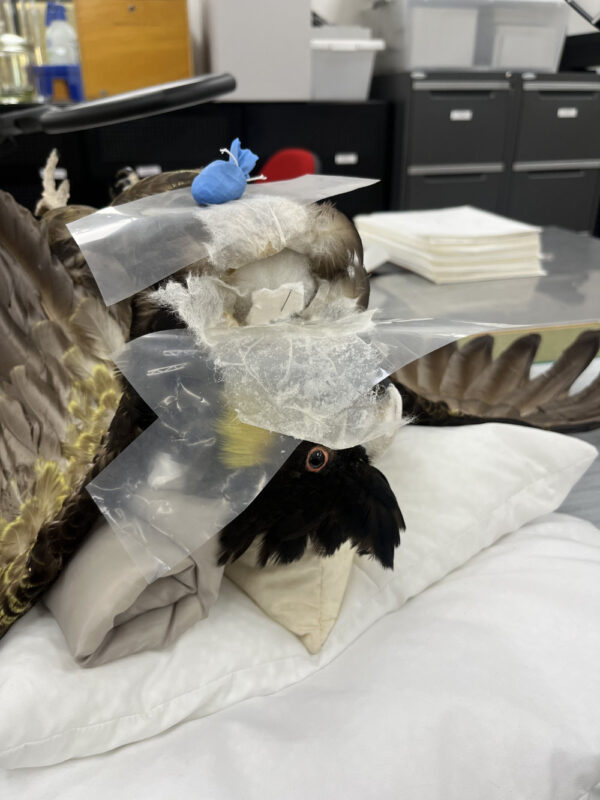
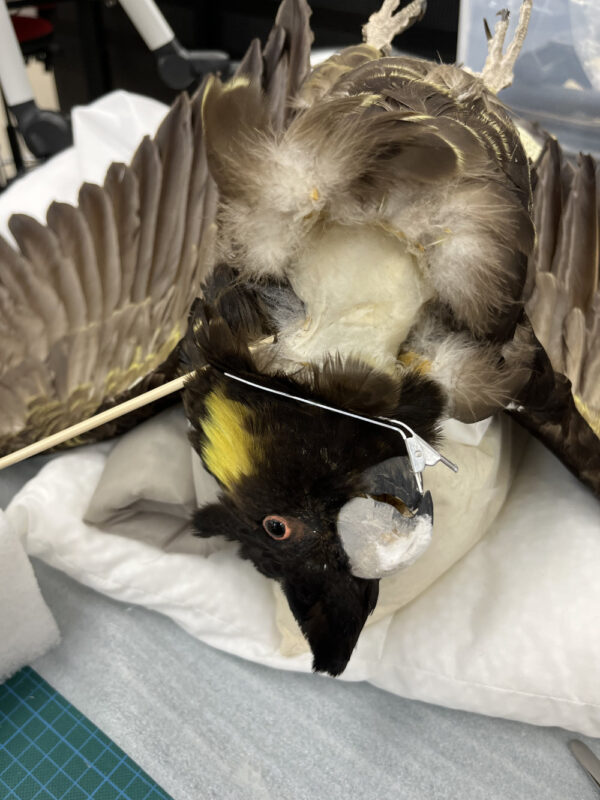
Yellow-tailed black cockatoo currently undergoing treatment to repair a large skin split. Images by Sophie Phillips.
Exhibitions
Bilas
Bilas: Living Culture opened in June to showcase the diverse and vibrant cultural material of Papua New Guinea. This was the first time the new acquisitions from the Southern Highlands of Papua New Guinea were displayed with guidance from community members on their assemblage.
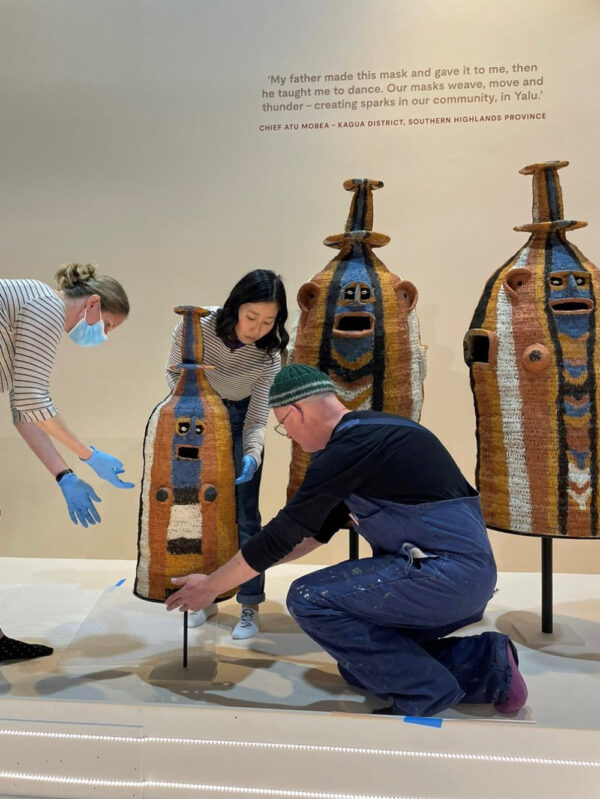
Lizzie, Kyra and Dave installing the Kagua body masks. Above right: Kyra installing the Raggiana bird-of-paradise on top of the Glong headdress
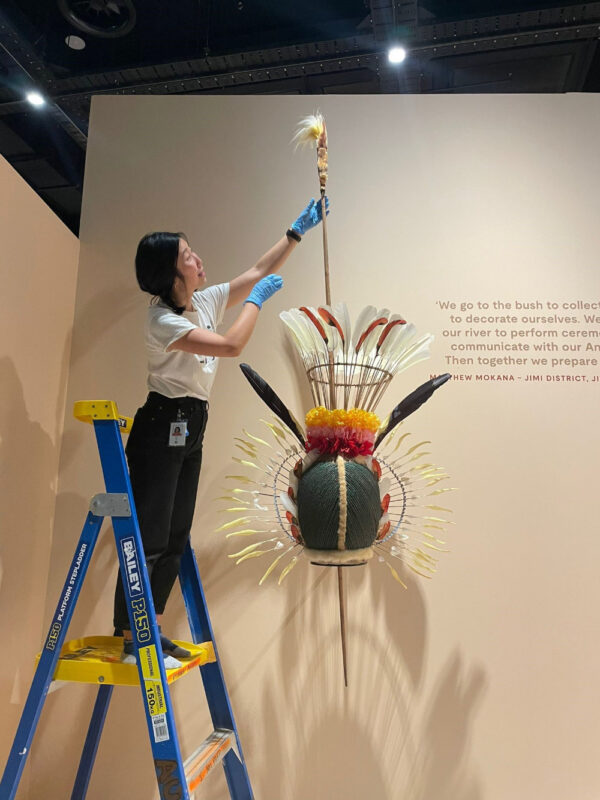
Kyra installing the Raggiana bird-of-paradise on top of the Glong headdress.
Interesting specimens from Life and Geosciences collections were prepared and installed, including several birds-of-paradise species, hornbill (Anthracoceros sp.), cassowary (Casuarius casuarius) and cus cus (Phalanger breviceps) mounts. Sheldon Teare also installed an array of shells, insects, and mammal teeth for the exhibition.
Wild Planet
Silvia Da Rocha has been working on an array of specimens added into our Biodiversity gallery. Silvia repaired one of our very rare quetzal (Pharomachrus antisianus) mounts and oversaw the safe installation of various pinned Odonata (dragonflies and damselflies), a polar skua (Stercorarius maccormicki), a pair of toucans (Ramphastos vitellinus) and Goliath beetles (Goliathus sp.).
Gallery redevelopments
Several permanent galleries have been de-installed, creating a lot of work for the whole CC&C team. Hundreds of Life and Geoscience specimens have been removed from one half of the Surviving Australia gallery. These specimens are working their way through pest management processes prior to condition assessment and rehousing for storage. The Pacific Spirit gallery has been de-installed and required the construction of large stillages to house large poles and slit drums. These galleries will be refurnished in the coming months.
Australian National Maritime Museum (ANMM)
Jillian Colrain from the Masters of Cultural Material Conservation program was with us for three weeks as part of the internship process. Jill’s major project was working on a large silver-plated centrepiece that slowly evolved into more of a hazardous materials and complex treatment project than was anticipated. Jill identified both the likely presence of a mercury tin mirror and the possibility of arsenic-contaminated textiles (though not analysed yet, precaution is always wise!)
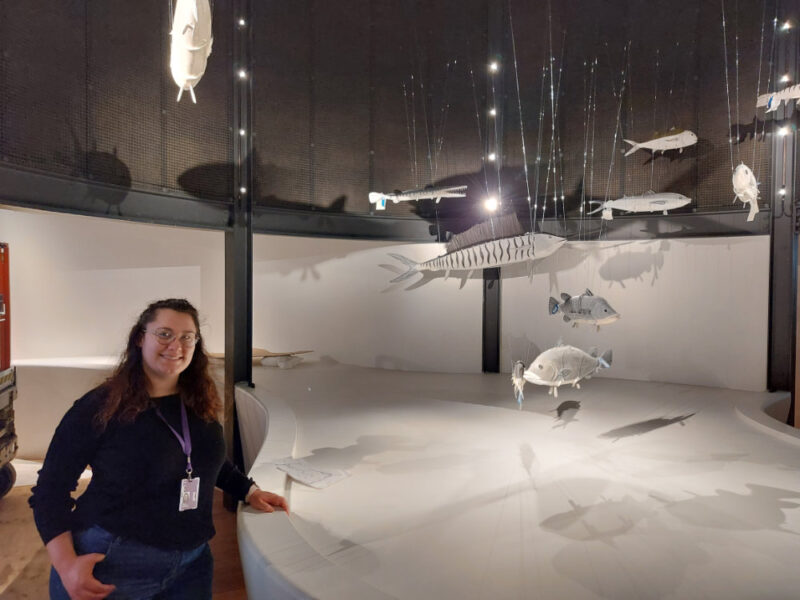
Jill in front of the newly hung Mäna and Bäru – The sea Country of Guykuda Munungurr.
Collection care
Tegan Anthes has been contracted to aid Agata Rostek-Robak and the team to develop the Collection Safety and Incident Response Plan (disaster planning).
It was with great relief that O’Sullivan Conservation was brought in to undertake a clean of some of the storerooms. Here, for six weeks, the team dealt with cleaning both the superstructures and some of the objects in the Large Objects Store and the Medium Objects Store. Agata has been liaising with contractors in the Museum to do an afterhours high-level clean of the structure. Objects on open display and certain showcases require covering and then checking the following morning.
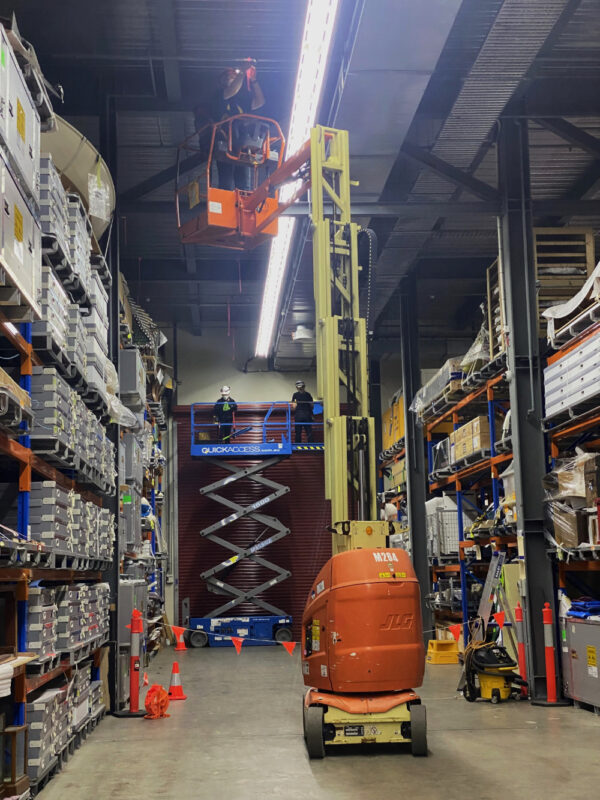
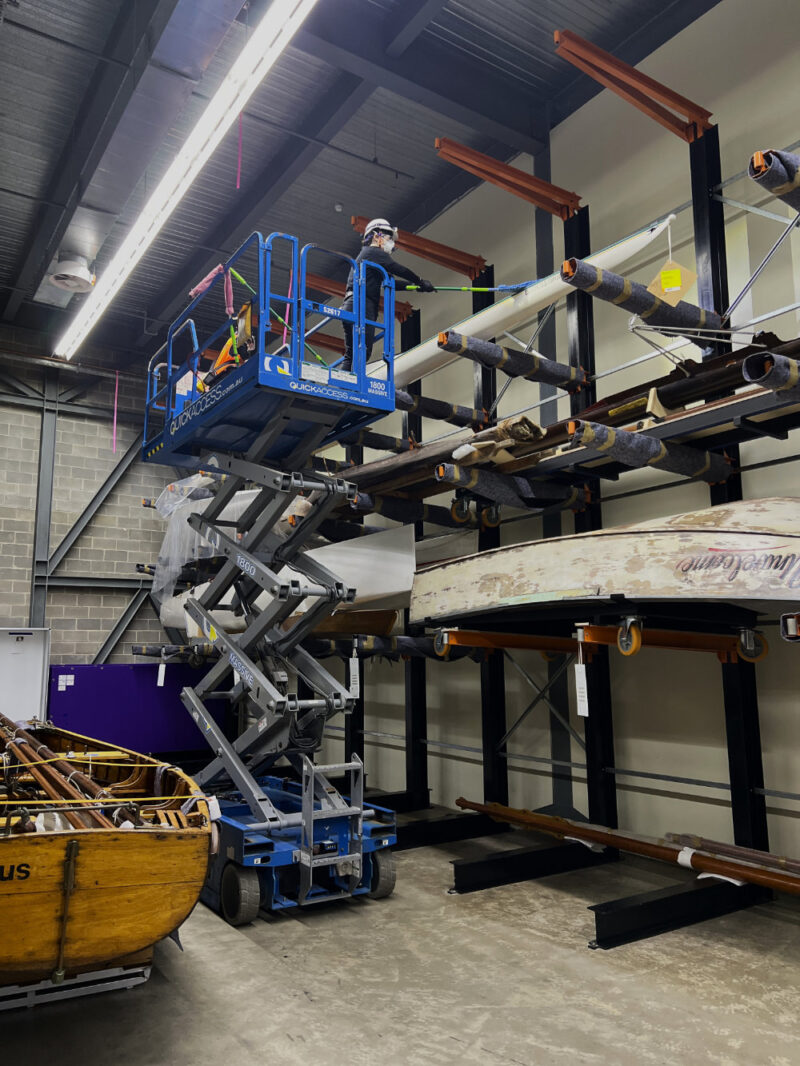
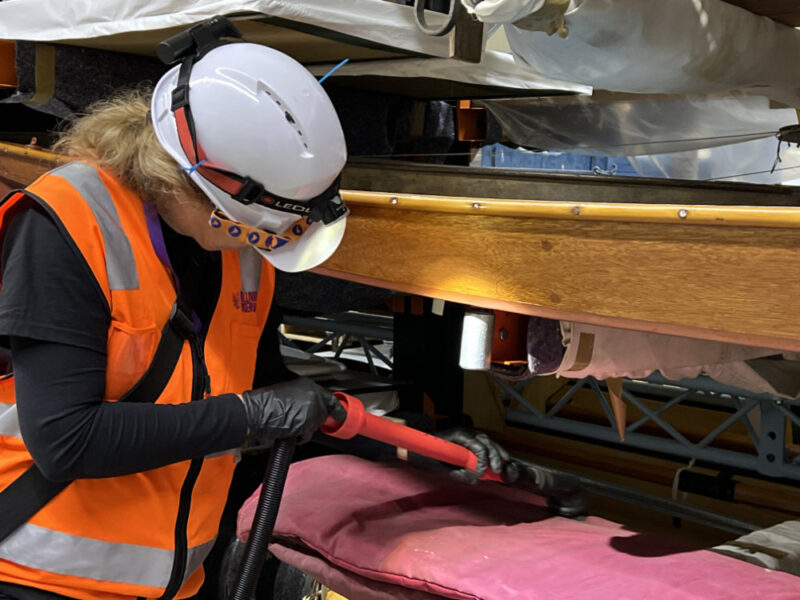
The O’Sullivan Conservation team in our Large Objects Store.
Large projects
The Tu Do conservation project led by Jeff Fox is making progress. In conjunction with Matt and Teressa (a husband-and-wife duo) from Allpoints Shipwrights, Tu Do is getting some much-needed repair works on the decking, which will make it more water-tight, remove much of the rotted wood and make it more structurally stable. This is the first stage of the project, which will likely end in mid-August. The second phase is scheduled to start the following month. Matt and Teressa are accustomed to working on heritage vessels, welcoming the notions of minimal intervention and retaining as much original wood as possible.
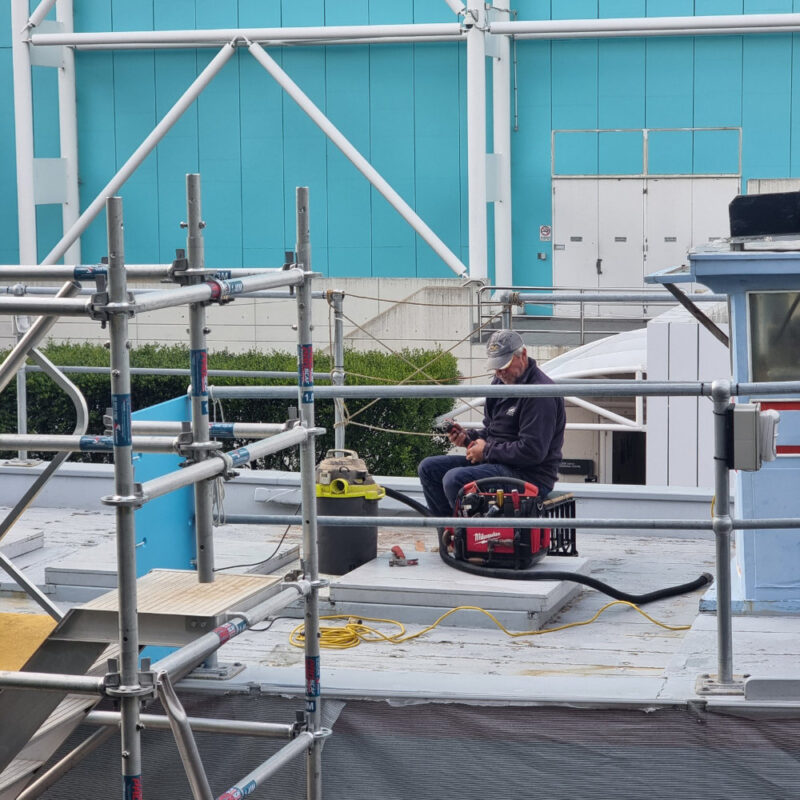
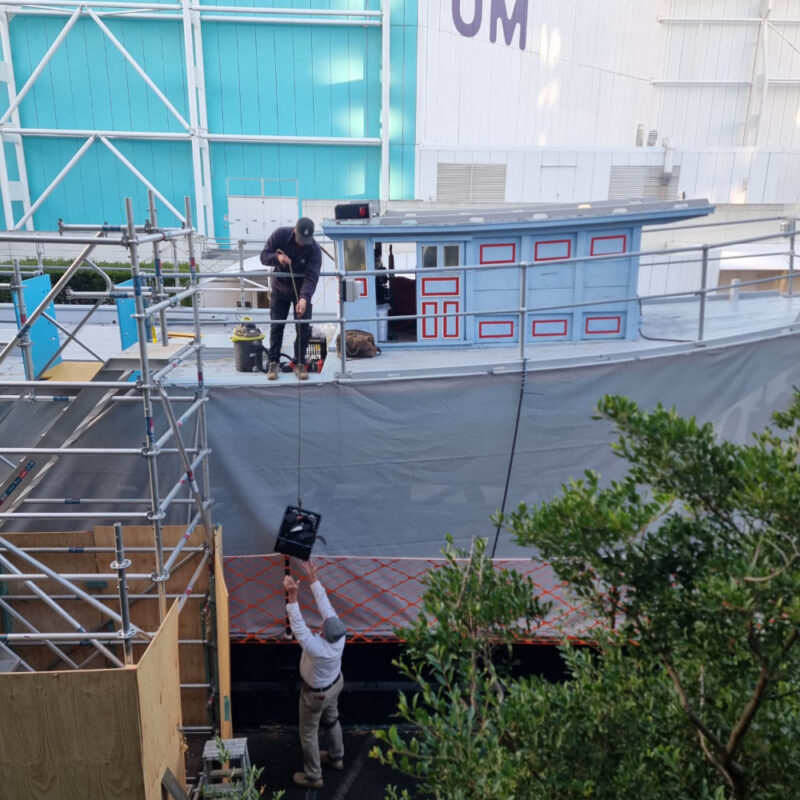
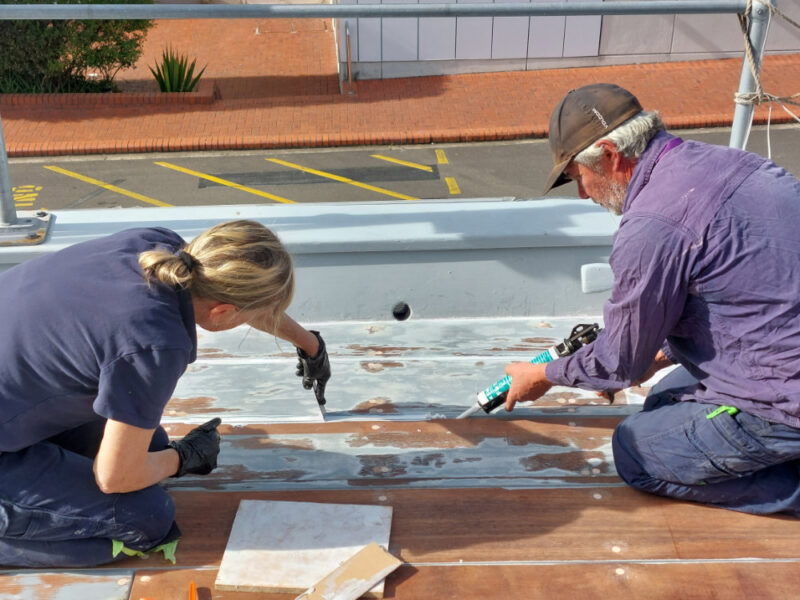
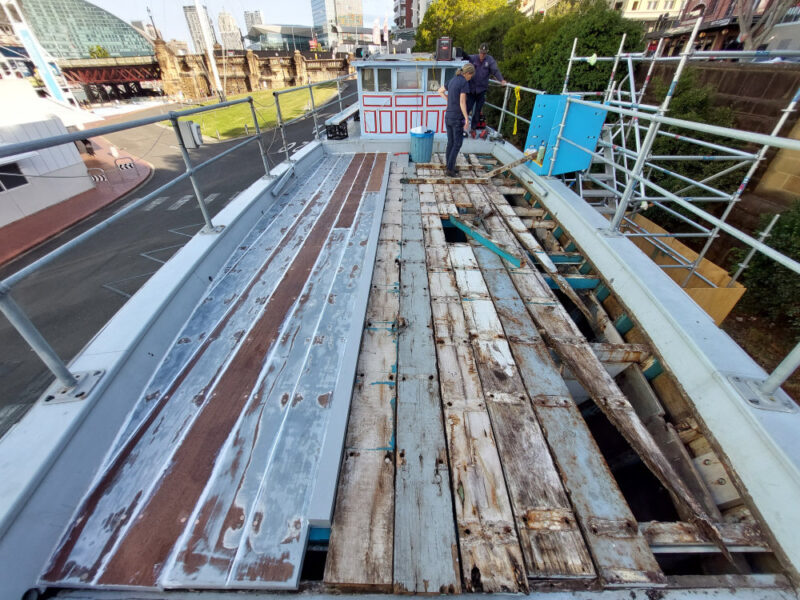
Matt and Teressa working on the deck of Tu Do. The lower image shows a comparison of the repaired deck with the old.
Under the watchful eye of Nick Flood, the Cape Bowling Green lighthouse has undergone its yearly engineer’s inspection, an interior and exterior clean, replacement of the balcony’s waterproofing, and some much-needed maintenance updates like inspection and investigation into the windows and wooden window frame by a heritage expert, and replacement of rotten wood. The vents in the lantern room have slowly been removed by Emma Hayles to treat corrosion and replace waterproofing.

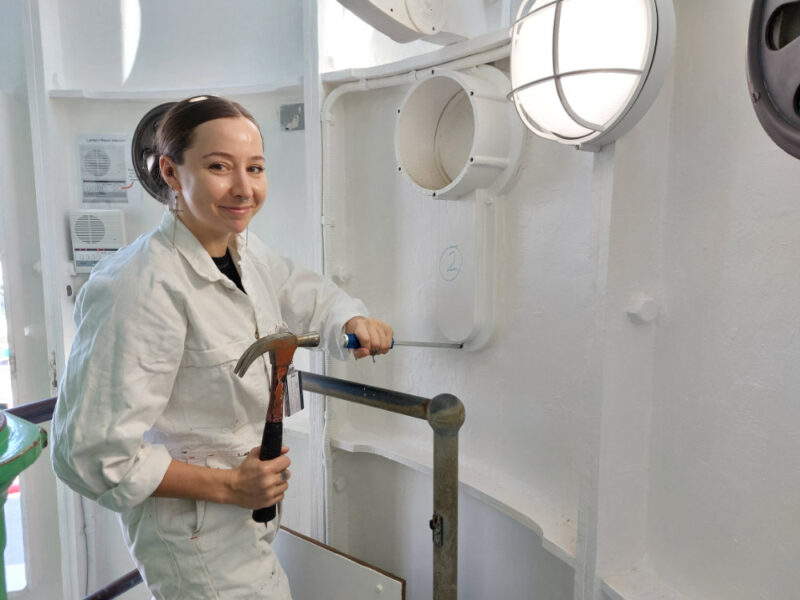
The lighthouse getting a thorough exterior clean, and Emma looking a little too happy about removing vents.
On Wednesday mornings during the recent winter school holidays, visitors to the Museum were treated to a display of the weekly maintenance of the HMAS Kara Kara engine. Fleet volunteers (Peter Baldridge and Eric Deshon) and Nick engaged with wide-eyed families, sharing facts and the history of the engine as it slowly turned over in front of them. Intern Jill got the chance to help on what is becoming a right-of-passage for all our interns – the early start Kara Kara maintenance.
Michael Rampe from Rampe Realistic Imaging was at the Museum recently to capture and reconstruct 3D objects. Michael had previously been on-site to capture the interior and engine room of Tu Do for greater accessibility. This time around he captured images of a number of objects including the Blaeu Globe and the freshly pest-treated ningher canoe. Nick was asked to provide assistance with handling objects, and spent a session with Michael learning about the techniques and capture methods, and ways the team can use these high-resolution 3D images.
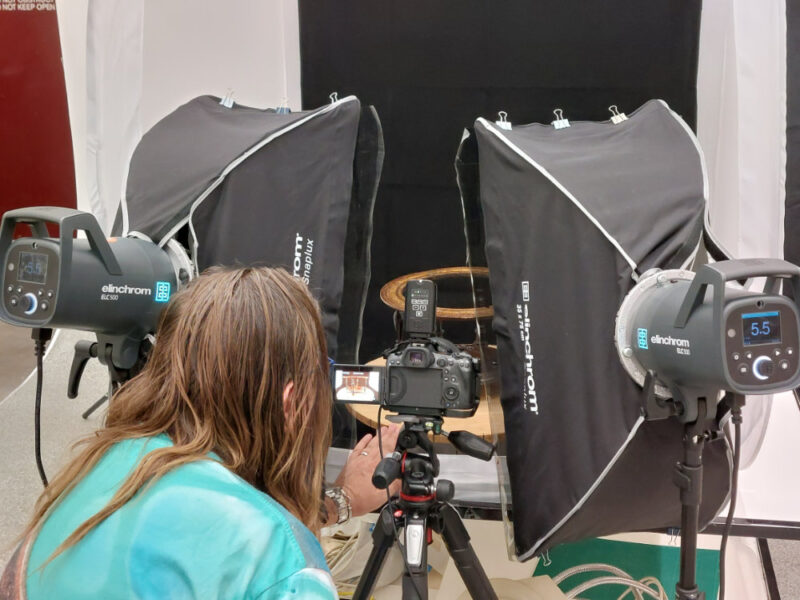
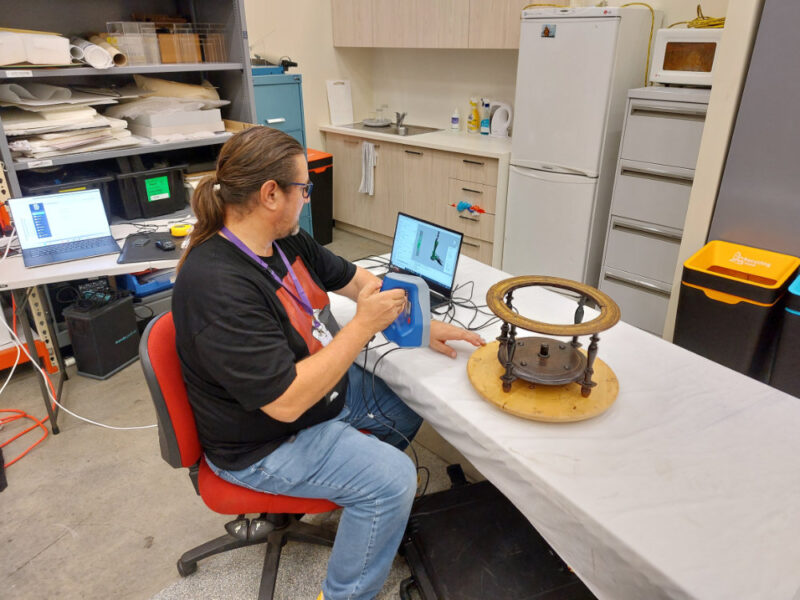
Michael capturing images of the Blaeu Globe base.
Exhibitions
Jeff, Emma and Kevin have been hard at work preparing objects, plinths and crates for the travelling component of Mariw Minaral (Spiritual Patterns). Due to head out in the first week of August (commencing at QVMAG Launceston), the large-scale format of the 2D and 3D works has made the process challenging. POD Museum and Art Services Pty Ltd was brought in to crate up the dugong on its display plinth, with the notion that most of the works could be easily installed and required minimal output from lending institutions.
Mäna and Bäru – The sea Country of Guykuda Munungurr is finally swimming in the Bamal space. Eighteen fish (and one crocodile) were scheduled for hanging display. Preparator Kevin Bray made cradles and brackets for each, and these were then painted to match the colours and patterns of each individual fish. These were then individually hung from the ceiling using fishing wires – a time-consuming process, as each was hung at a specific height and angle to fulfil the curators’ and designers’ vision. The effort was well rewarded as the space is truly lovely.
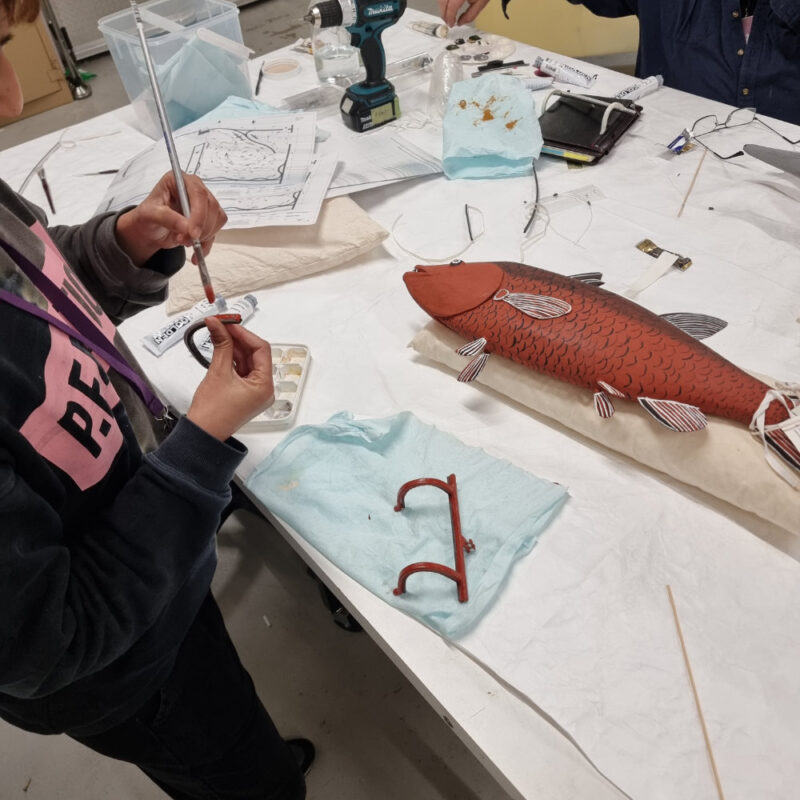
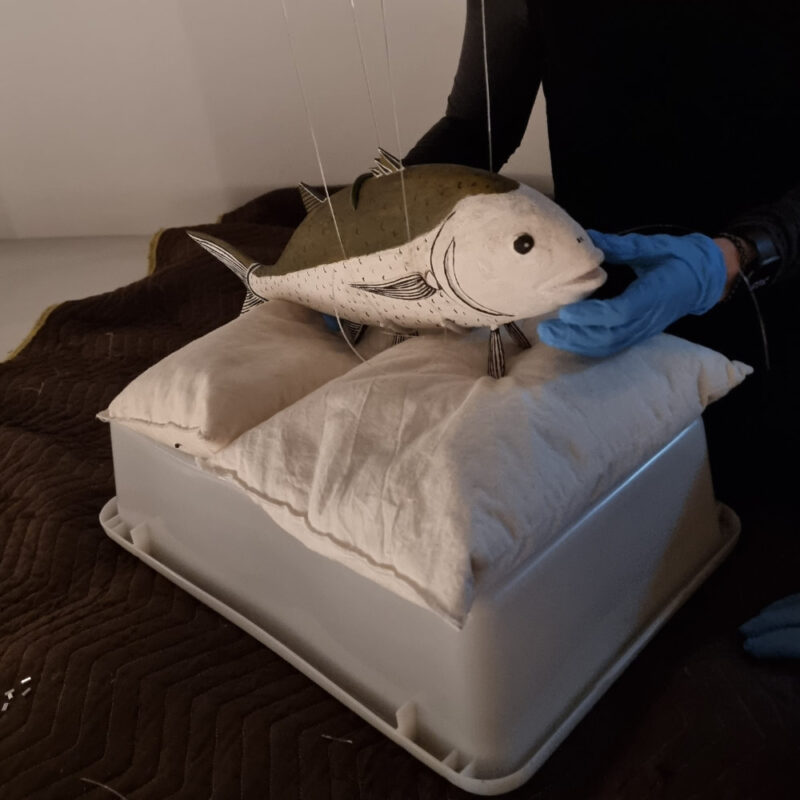
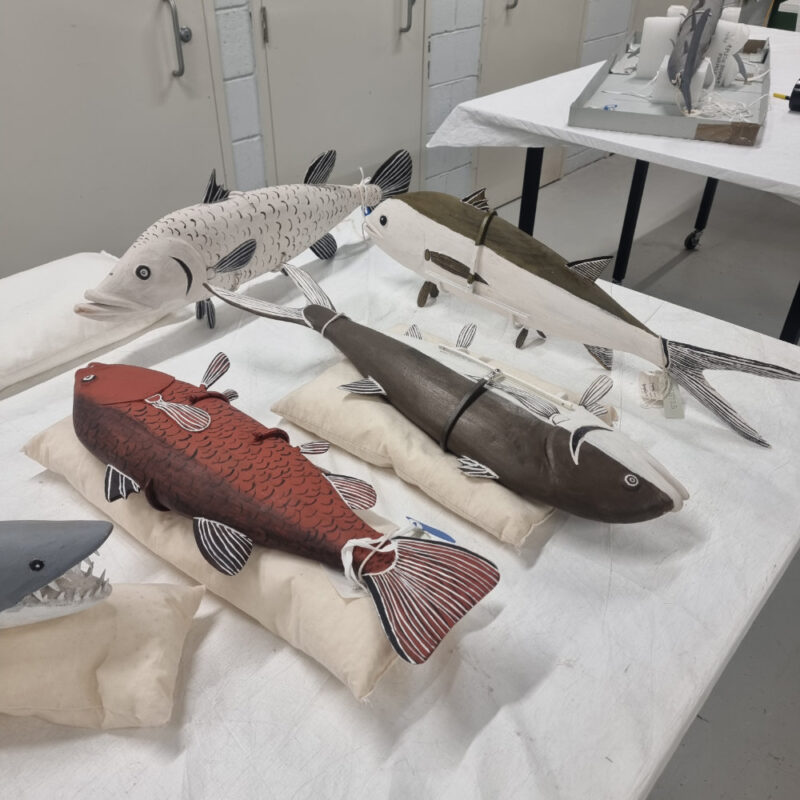
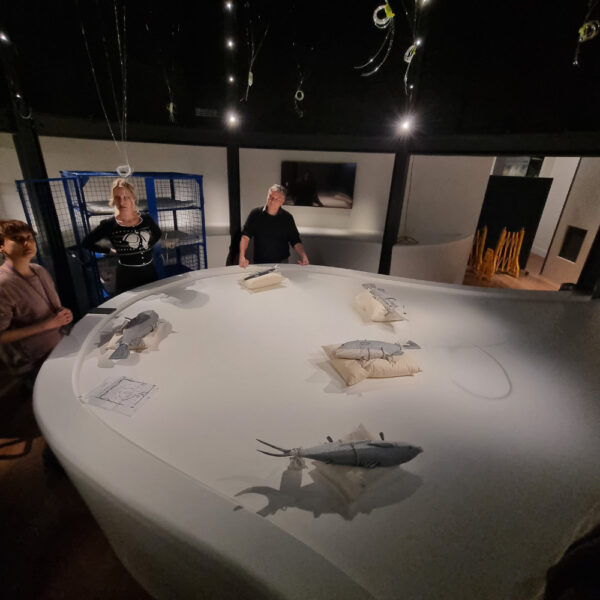
Images from the painting and hanging of Mäna and Bäru – The sea Country of Guykuda Munungurr.
Alayne Avis has been working on preparing the summer exhibition, and a number of large posters to accompany the Wharfies’ Mural in the Tasman Light Gallery. On 20 July, the Museum hosted a VIP delegation, which included the US Secretary of the Navy, Mr Carlos Del Toro, and Vice Admiral Mark Hammond AO, Australian Chief of Navy. The group toured sections of the Museum and viewed some of our US collection items, including the USS Canberra bell and the beautifully polished replica America’s Cup that Alayne diligently worked on. To safeguard the objects and engage with delegates, Alayne and Myf Bryant from Registration were present during the viewing. Alayne has also been borrowing the expertise of Fleet to remove the sails on Blackmores First Lady (in which Kay Cottee circumnavigated the world non-stop) so that they can be assessed and given a well-deserved clean.
Jeff has helped facilitate two members’ talks – one on the shipwreck of the Dunbar, which occurred near the entrance to Sydney Harbour in 1857, and another on the pearling industry. These talks are aimed at not only informing our members about maritime topics but allowing them to view some of the collection that isn’t on display – whilst conservation treatment isn’t always required prior to these events, Jeff works to condition report and provide adequate supports for these collection items and to ensure their safe presentation.
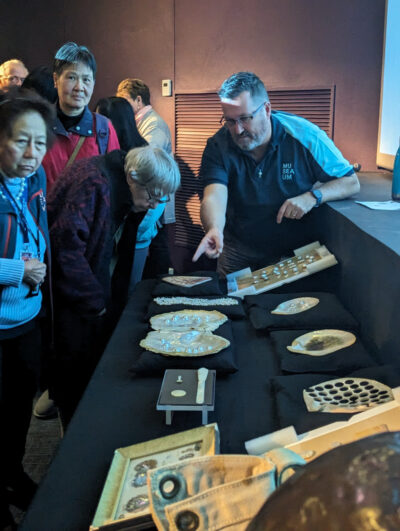
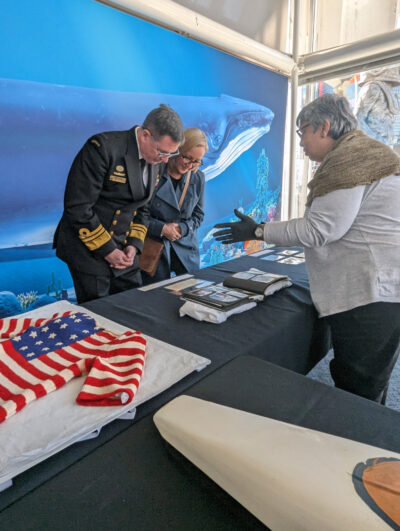
Jeff and Alayne talking to members and delegates alike about the collection.
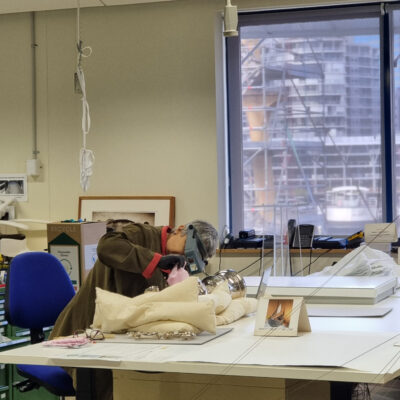
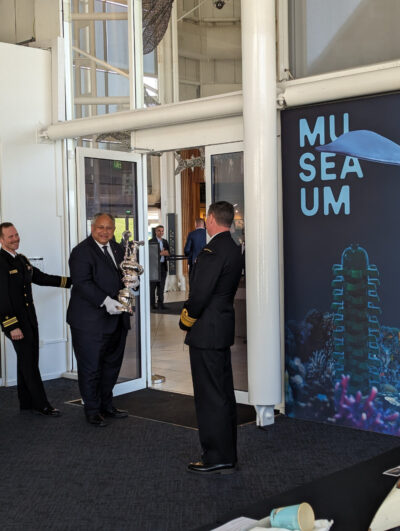
Alayne polishing the replica America’s Cup, and the US Secretary of the Navy, His Excellency Carlos del Toro, pretending to make off with the trophy, leading Alayne to wonder, jokingly, about the diplomatic consequences of taking out a senior member of the Biden Administration.
Events
Agata and Emma gave a talk entitled the Plastics Paradox in conjunction with Seabin on-site, which focused on plastics within the collection, their degradation and care. The 30-minute talk, attended by 20 people, received positive feedback, with many of the general public admitting to never having considered issues of plastic degradation within collections.
Nick, along with AICCM, hosted an event looking at the history and conservation program for Pyrmont Bridge. The event featured speeches by several dignitaries including David Glasson, Pyrmont Bridge Maintenance, Property NSW (and weekend Museum volunteer) who is the sentinel who operates the Pyrmont Bridge. Afterwards the group moved up to the bridge to stand on the swing span while the bridge opened, with a few given the opportunity to inspect the cabin with Graeme Curran (fleet engineer). The event provided a rare insight into the delicate and detailed conservation and research work required to keep the bridge in operational condition. (See separate article in this newsletter.)
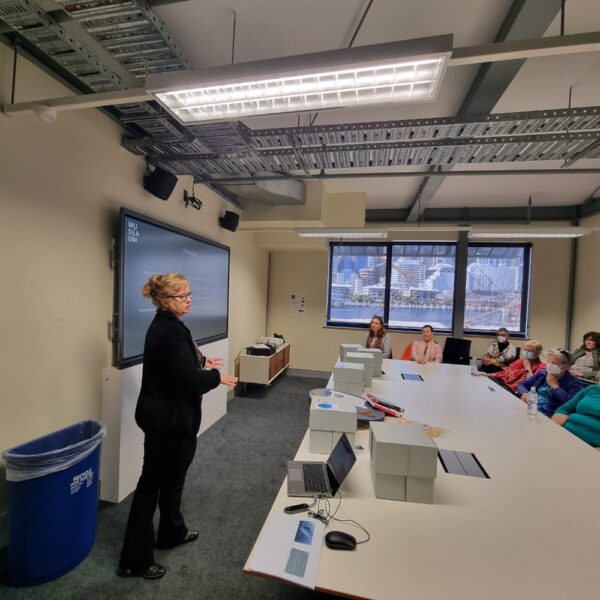
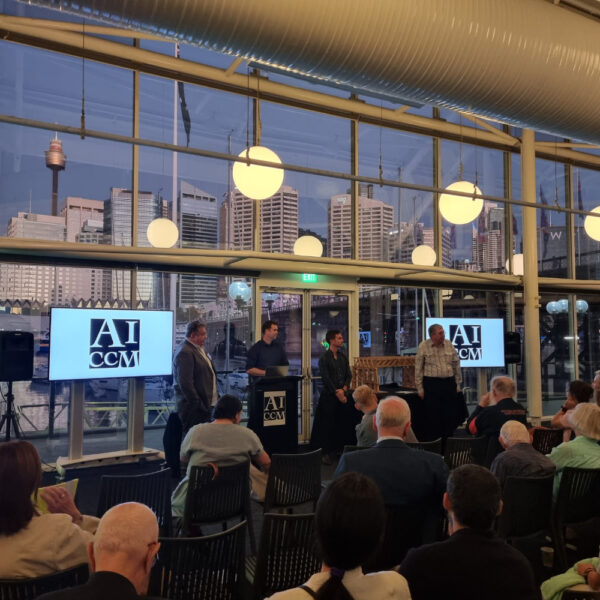
Agata and Nick leading their respective talks.
Workshops and tours
The team has undergone several training sessions at Yalagan Registered Training, after which we can safely work at heights, and drive around and operate EWPs (elevated work platforms), booms and forklifts, even those over 11 metres. No doubt this will come in handy for some of our bigger projects.
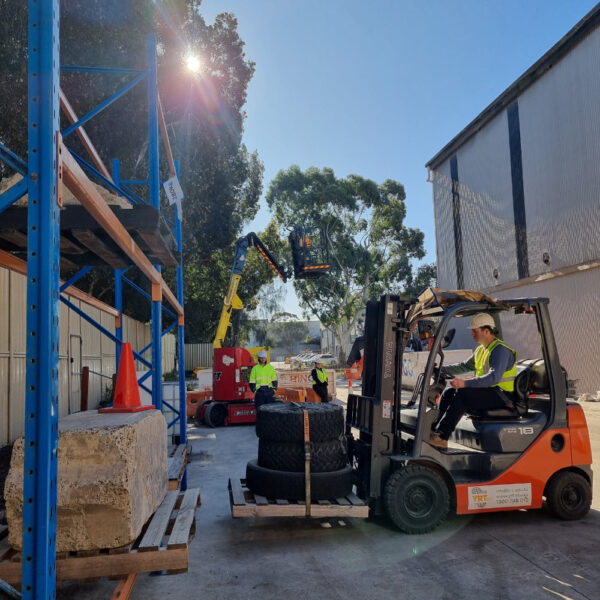
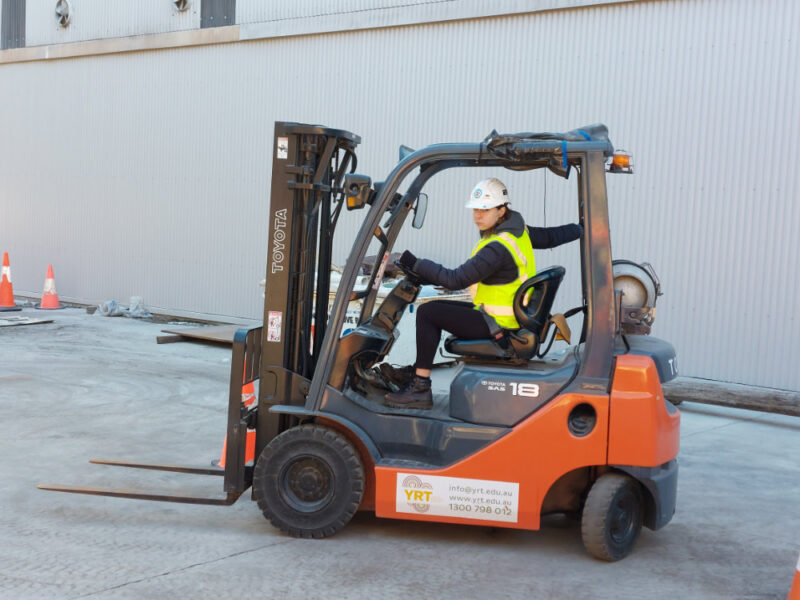
Nick and Emma undertaking their forklift training … Emma can’t drive a car, but she can now drive a forklift!
Emma and Nick attended the three-day Bruker XRF mapping workshop at the Art Gallery of NSW. It was fascinating to see the device working in real time, what it can accomplish, and some of the information the Gallery was able to obtain about their paintings. Emma was lucky enough to head up to Newcastle to attend the Australian Museums and Galleries Association (AMaGA) conference at the beginning of May. It was great to see what other institutions have been working on and dealing with, and the conference’s theme this year – ‘discomfort’ – was a poignant topic of discussion. And Emma, Jeff and Alayne visited Sydney Analytical at the University of Sydney on a Friday in July to view the facility’s new equipment. Dr Elizabeth Carter was very accommodating, showing us around and discussing some upcoming projects for her team.
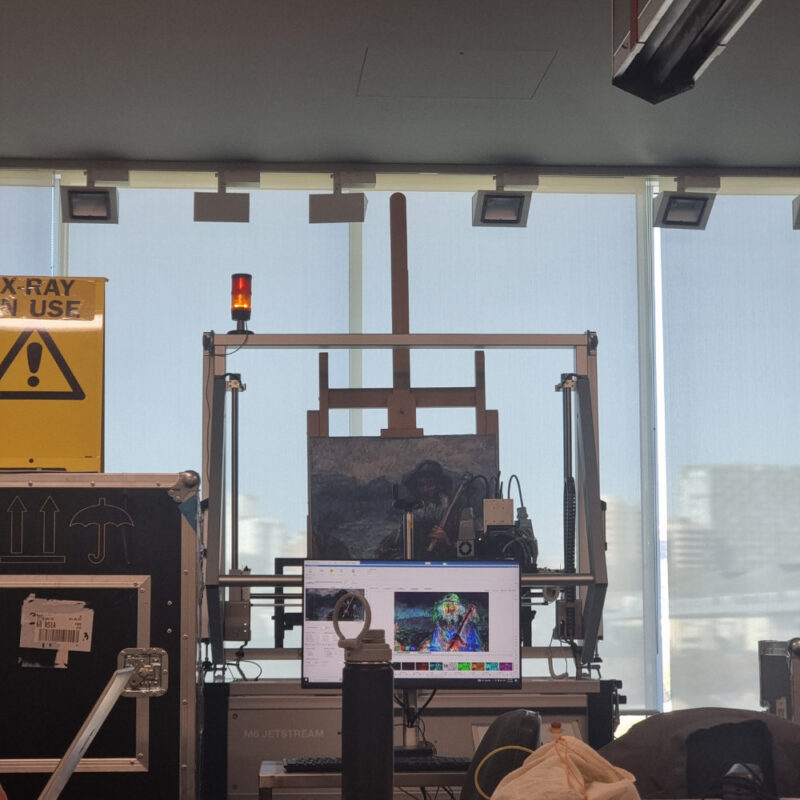
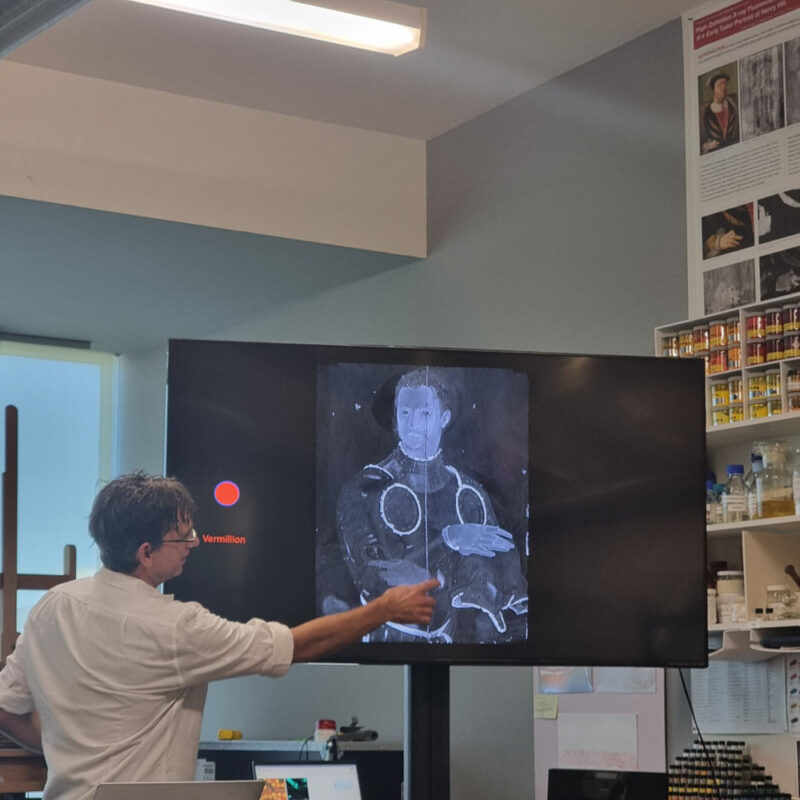
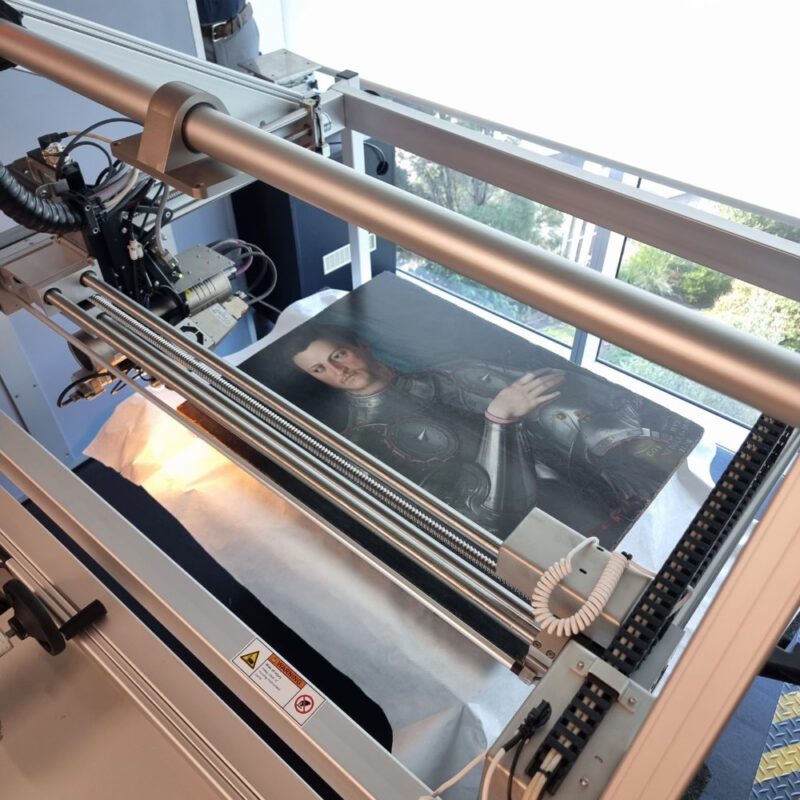
Some of the fascinating behind-the-scenes shots of the Bruker XRF mapping workshop.
International Conservation Services (ICS) New South Wales
Paintings
An intriguing discovery was made during recent building works at the famous Niagara Café in Scone revealing a mural, believed to have been painted in the late 1950s, hidden beneath overpaint. ICS conservators got to work with careful overpaint removal, a slow-going and meticulous process, to unveil an Americana Country and Western-themed mural extending across the entire 17-metre building wall. Head of Conservation, Fine & Decorative Art Adam Godijn, Senior Paintings Conservator Alis Jitarescu, and conservators Francesca Elia, Maria Vincente and Issy Legg worked on this extensive project, which included cleaning, stabilisation of flaking paint, fills, and retouching.
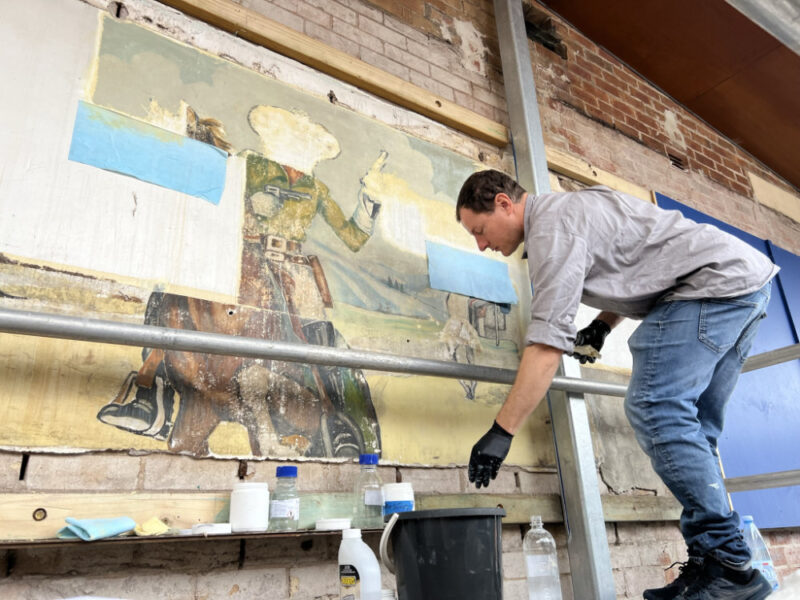
Adam conducting overpaint removal to uncover the original mural.
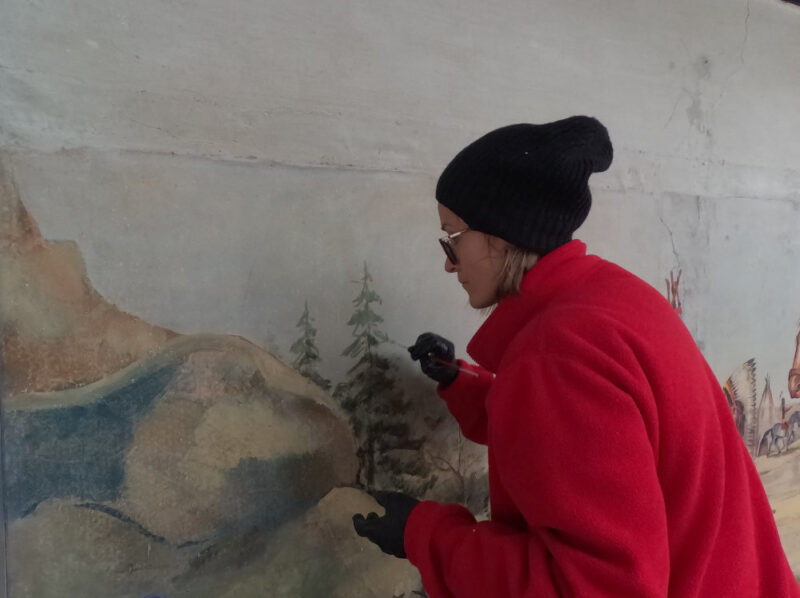
Alis retouching lost and damaged sections of the paint.
Textiles
In the Textiles department, Yolanda El Khouri and Elric Ringstad have been on-site in private residences installing a large Uzbek Suzani and a smaller tapestry. Yolanda recently undertook the preparation and mounting of a large Chinese embroidery from the White Rabbit Gallery, and is currently overseeing the printed reproduction of an early document printed on silk from the Sydney Eisteddfod. Yolanda was also heavily involved in the conservation and mounting process of a 1920s lampshade with dangling beads and a beaded jacket for exhibition inHome in St George 1920–1960 at the Hurstville Museum & Gallery. Meanwhile, Bella Taylor has been applying Velcro hanging systems to two heavy rugs from the White Rabbit Gallery, and is currently carrying out a large rehousing project of costumes for the Museums of History New South Wales (MHNSW).
Christina Ritschel has been conserving costumes from the movie Dogs in Space from the collection of the National Film and Sound Archive. She has also been liaising with the Art Centre Melbourne and Costume Mannequin Solutions to have a bespoke mannequin produced for an opera costume worn by Dame Joan Sutherland.
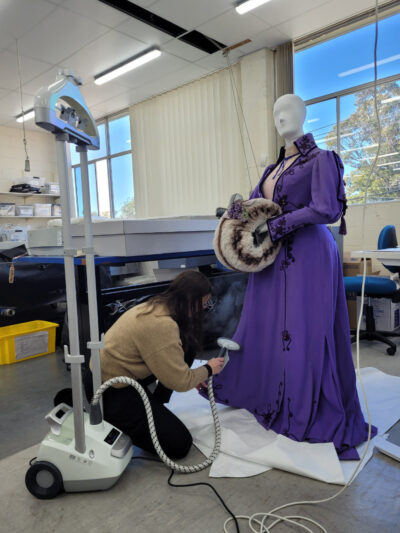
Christina preparing the final touches of Dame Joan Sutherland’s opera costume on its custom mannequin.
Christina has nearly completed the stabilisation of a shattered silk lining of a red hunting coat from the MHNSW, and is also completing work on the green leather upholstery in the House of Representatives Chamber of Old Parliament House, Canberra.
Objects & Built Heritage
ICS conservators ventured down through the labyrinth of disused tunnels around St James Railway Station to establish the current condition of known documentary evidence of their use in WWII, including posters, painted inscriptions and graffiti. The walls contain an assortment of graffiti, the oldest of which are the pencilled names and serial numbers of soldiers dating from when the tunnels were used as bomb shelters during WWII.
The assessment confirmed the existence of three WWII air raid shelter posters and also revealed substantially more names dating from the 1940s. A photographic record of the walls using ultraviolet and infrared light was undertaken to allow desktop analysis of the graffiti to identify more inscriptions.
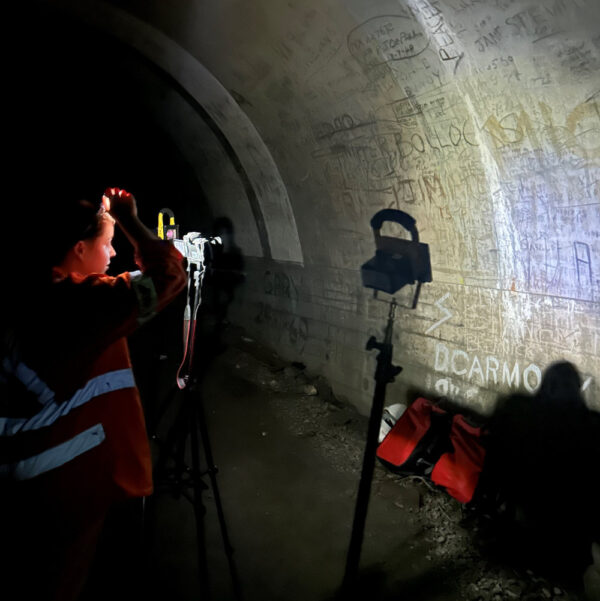
Documenting World Heritage-listed graffiti.
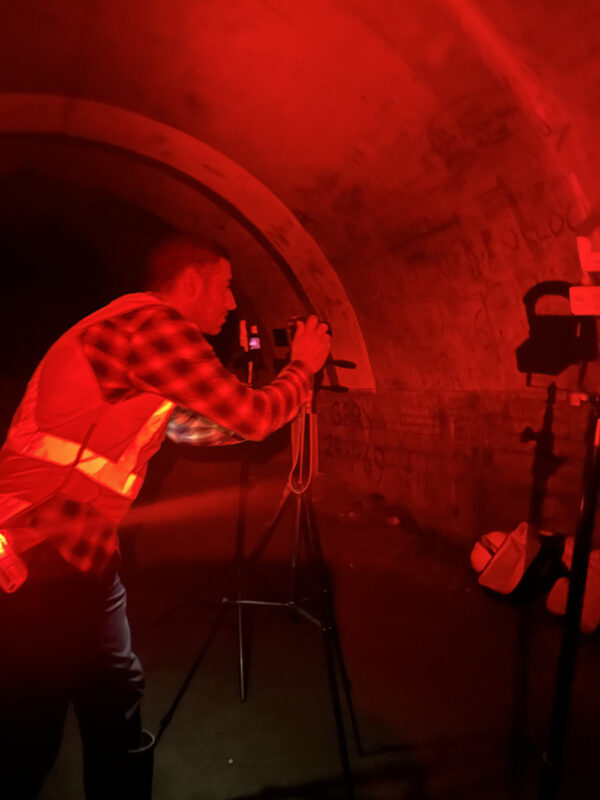
Shrief Eissa using infrared light to document the tunnel’s graffiti.
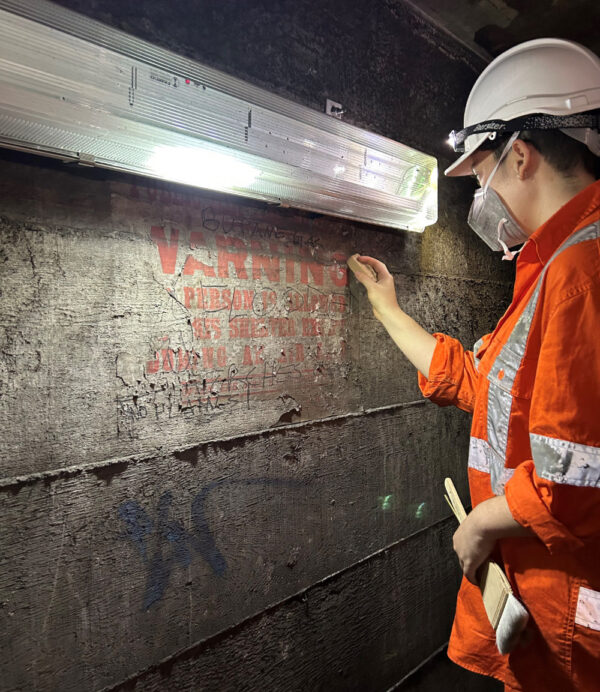
Treating WWII air raid shelter posters in the St James tunnels.
The Objects & Built Heritage team has been working on many more projects including treating two marble dogs at the front of Retford Park House for the National Trust of NSW.
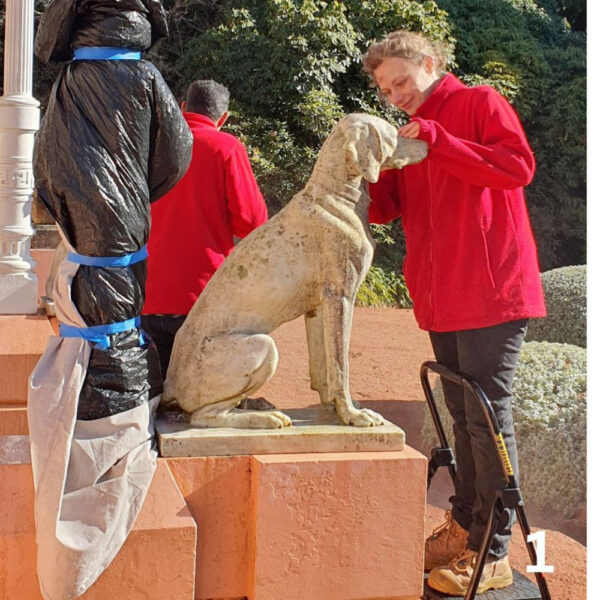
Dirt and lichen being removed from the marble.
Paper
Our paper conservators have been busy. Caroline Whitley and Shima Gholami have worked on a large rehousing project of photographic materials that will eventually be going to State Records NSW.
Katie Wood treated a large Chinese artwork measuring two metres by one metre, which had heavy discolouration and acidic staining. The treatment included washing the parchment via immersion, which was a particular challenge due to the large size and fragility of the paper. The treatment proved to be worthwhile, however, with good results and a reduction in stains.
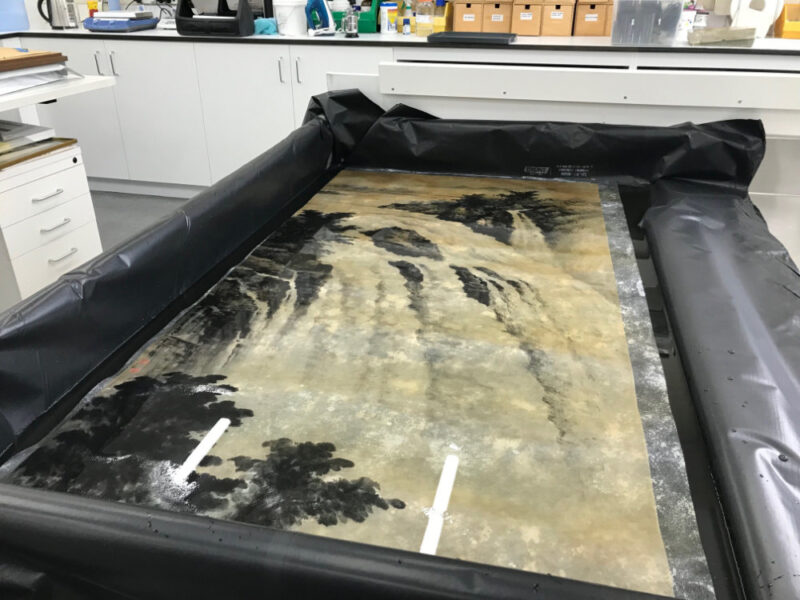
Artwork immersed for stain removal treatment.
The update of the paper lab at ICS Sydney continues, with ongoing refurbishment of the working space and improvements to our storage facilities.
Frames and Furniture
The team recently completed a beautiful clean and repair of timbers for the iconostasis at St George Cathedral in Redfern. Frames and Furniture conservator Mark Searle is currently working on an intricate bronze paint removal and surface cleaning of a very fine gilded table base for the Queen Victoria Museum and Art Gallery, Launceston.
The team working on the treatment of St George Cathedral’s iconostasis.
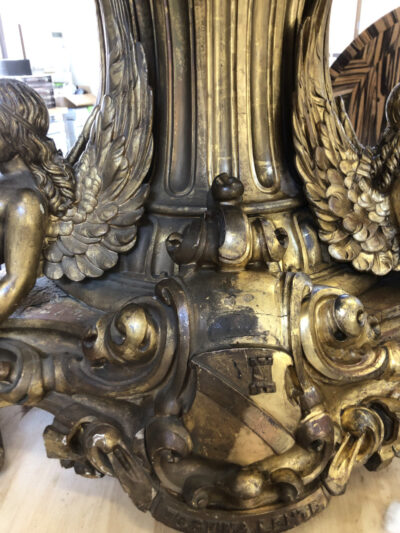
Gilded table base half-way through treatment.
O’Sullivan Conservation (OSC)
Staff news
O’Sullivan Conservation continues to expand its skills and capabilities with the addition of three new staff members. Mathew Geale joins the team as Metals Conservation Specialist, having run his own metals restoration and jewellery-making business for over a decade. Mathew brings his wealth of knowledge and experience in corrosion treatments, metal finishing and patination, and silversmithing to both studio and on-site projects. Kimberley Chung and Georgina Wiley also joined the team as Assistant Object Conservators for a large-scale conservation cleaning project at the Australian National Maritime Museum. Our mid-year celebration brought the whole team together at the end of this project to celebrate our achievements so far this year.
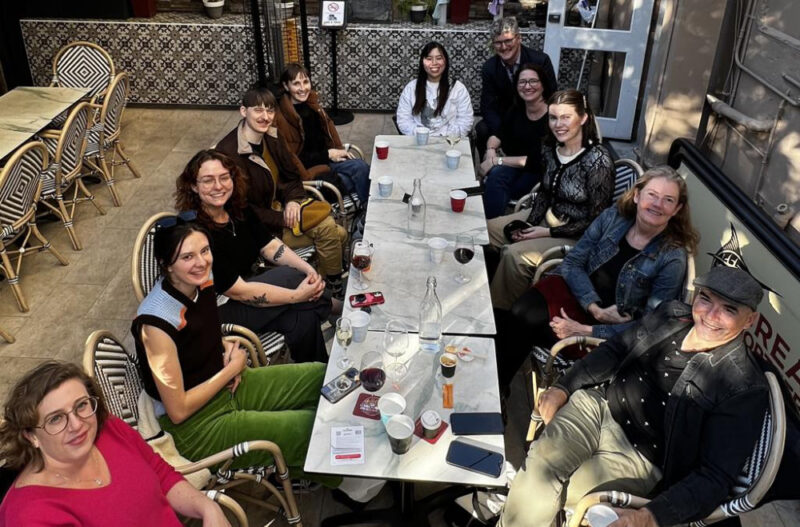
The OSC team enjoying our mid-year celebration!
Professional news
It was a great privilege for the team to be invited to attend the National Trust (NSW) Heritage Awards, held at Daltone House in Pyrmont in May. O’Sullivan Conservation is proud to support the conservation and maintenance of Judy Watson’s marble sculpture bara, Monument for the Eora, the winner of this year’s award for Aboriginal Heritage. The Archibald Memorial Fountain, for which OSC undertook quality control for the bronze conservation works, was also highly commended in the category of Conservation of Built Heritage.
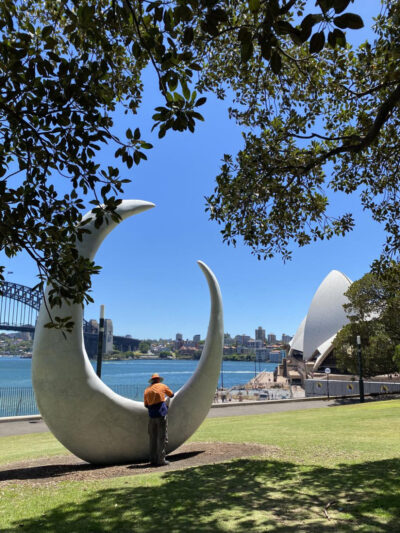
Cleaning bara – Monument for the Eora by Judy Watson, winner of the 2023 National Trust (NSW) Heritage Award for Aboriginal Heritage.
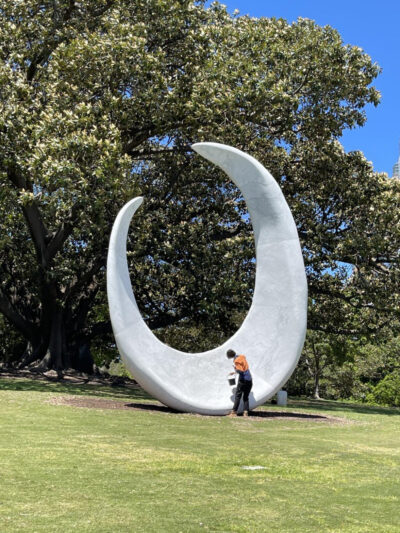
Cleaning bara – Monument for the Eora by Judy Watson, in the Royal Botanic Garden Sydney.
Eoin and Hannah thoroughly enjoyed this year’s AMaGA conference in Newcastle in May. Over 500 delegates from around Australia and internationally joined together for conversations around the conference theme of ‘discomfort’, including topics affecting museum collections such as climate change, trauma and healing, and repatriation. We particularly enjoyed the Australian Museum’s discussion ‘NOT the Colonial Museum? Historic practices & their representation in modern natural history museums’, delivered by Dr Mariko Smith, Rehan Scharenguivel¸ Silvia Da Rocha, which is an area that warrants further discussion in the conservation and museums industries.
In July, the Solvent Gels workshop held at AGNSW was attended by Katherine, Camilla and Kimberley. It was wonderful to see the potential of this material for cleaning projects and we were given the chance to test out its capabilities in the AGNSW labs.
Also in July, Hannah attended For Our Elders: A Night of First Nations Self-Determination at the Australian Museum, which celebrated the story of Ngarigo woman Nellie Bungil Walker (Nanny Nellie). The new temporary display in the First Nations Gallery was unveiled by Nanny Nellie’s great-granddaughter Aunty Irene Ridgeway. The display includes a likeness of Nannie Nellie by the 20th-century sculptor Rayner Hoff, and O’Sullivan Conservation is proud to be associated with the broader project in conserving one of a trio of sculptures by the artist.
Treatment projects
O’Sullivan Conservation was welcomed by the staff at the Australian National Maritime Museum in May and June to carry out a six-week preventive conservation cleaning project of the Museum’s large and medium object stores. The project saw us expand our team to include four conservator supervisors, five assistant objects conservators and two conservation technicians. Working at height, the team undertook top-down deep cleaning of the difficult-to-access storage areas, including the fabric of the building, racking, pallets and individual collection items, to remove accumulated dust through dry brush-vacuuming and aqueous cleaning where appropriate. ANMM no doubt now has one of the cleanest object stores in Sydney!
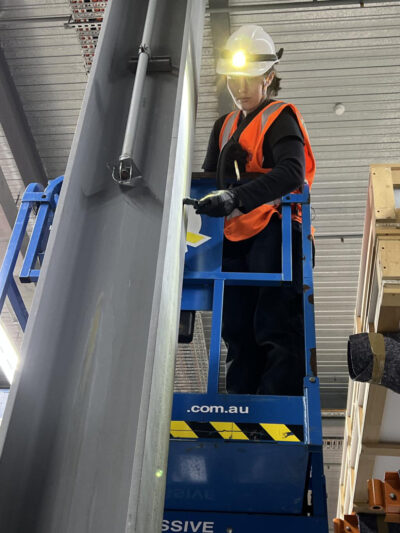
Anna Broome undertaking conservation cleaning at height at ANMM.
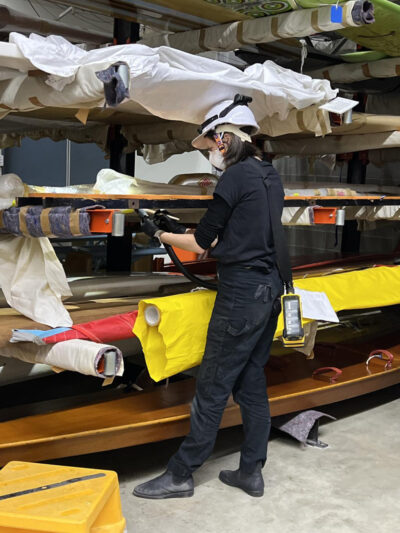
Georgina Wiley undertaking conservation cleaning in the storage of ANMM.
The City of Sydney engaged O’Sullivan Conservation to undertake the conservation treatment of Earth Mother, a rare example of a mid-20th-century playground sculpture by artist Anita Aarons. Located in the children’s playground at Cook & Phillip Park in Sydney, it is designed for children to crawl through, climb over, and slide across. Though structurally sound, the sculpture was in poor condition visually. The conservation treatment involved the careful removal of two layers of abraded and flaking paint from the surface, followed by removal and repairs to the cracked and unstable mortar at the interface between the two sections of the sculpture, and treatment of the exposed and corroding armature, prior to the application of a new colour-matched protective coating. Conservation treatment has returned this unique heritage-listed play sculpture to its original condition and reinstated the artist’s intent that it be both robust, visually appealing, and tactile for children’s play.
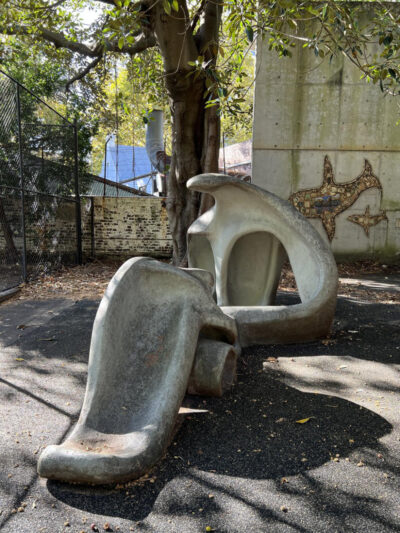
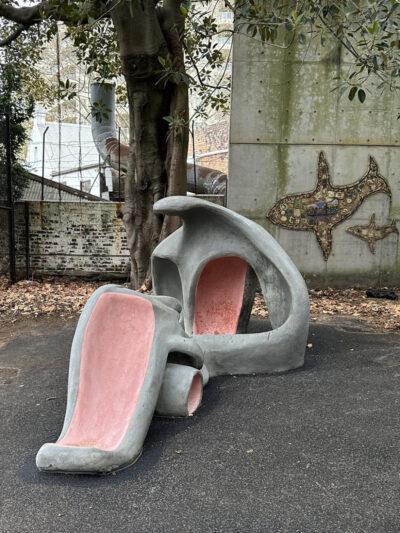
Earth Mother playground sculpture, before and after treatment.
O’Sullivan Conservation has carried out treatment of the sandstone plaque at Mrs Macquarie’s Chair in the Royal Botanic Garden Sydney. This included re-incising and in-painting three decorative details surrounding the lettering, with the help of historical photographs, as well as cleaning and biocide treatment of the sandstone. Emily fully utilised her industrial design and conservation skills, taking the lead on the project and completing not only the scaled-up drawings but also the inpainting and treatment of the plaque.
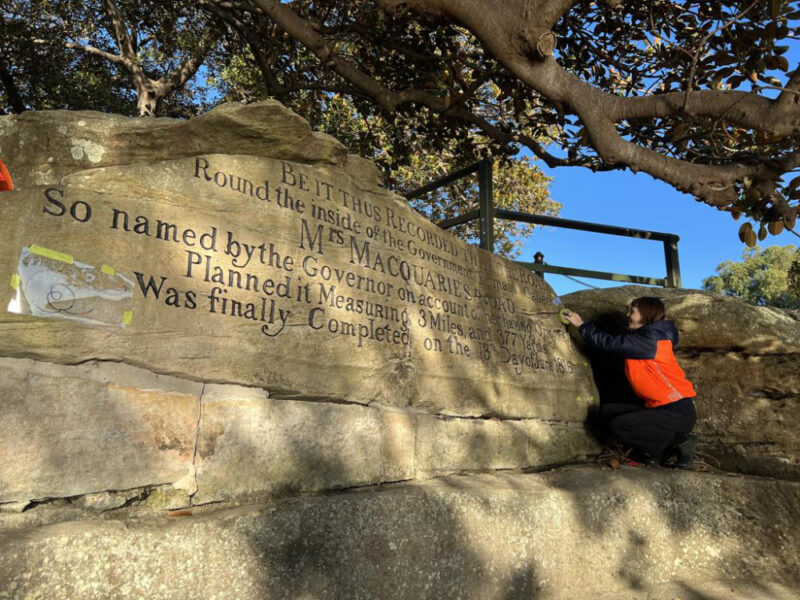
Emily Bramich applying the replicated design templates in preparation for incising the plaque at Mrs Macquarie’s Chair.
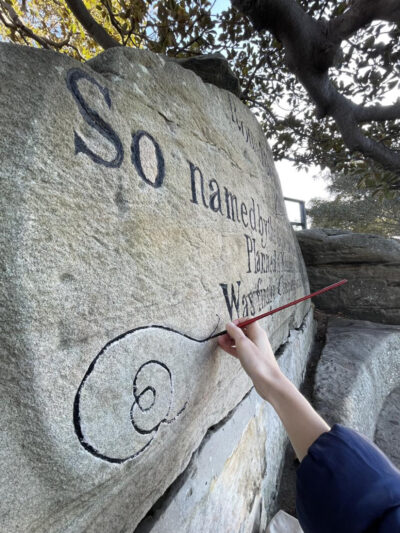
Emily Bramich inpainting the newly incised designs at Mrs Macquarie’s Chair.
Conservation treatment of the Stimson Memorial drinking fountain for Fairfield Council is now complete. The cast concrete construction had been relocated from its original location in the 1970s and was found in nearby bushland in 2021. Focusing on preserving the piece in keeping with its age and use, conservation involved low-pressure washing, analysis of the numerous coating layers, removal of the existing coatings, loss compensation, and recoating. The memorial was reinstalled in Fairfield City in the revitalised parklet near the Fairfield rail, and OSC has fabricated and installed a new interpretive plaque.
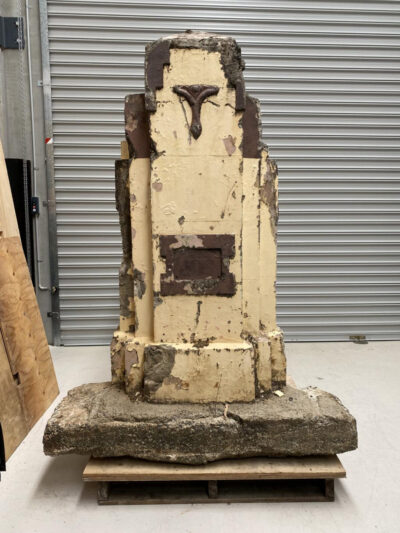
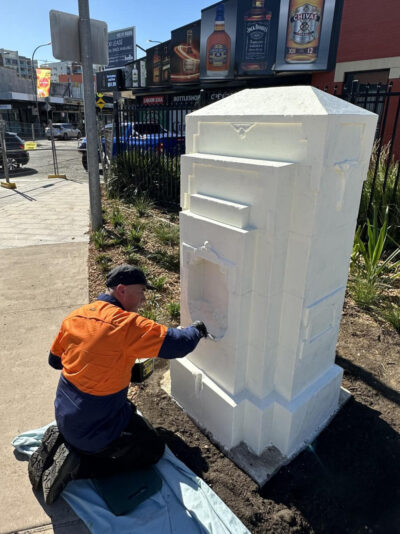
Stimson Memorial before treatment, and Mathew Geale applying the final coating after its reinstallation in Fairfield City.
Artlab
Staff news
Helen Weidenhofer has been appointed Acting Director following Andrew Durham’s announcement that he will reduce his role as director from full-time to two days per week, ahead of retiring at the end of the year. Andrew has several unfinished projects he wants to complete before then, including the restitution of the recently re-discovered Yirrkala bark petition to its community in Arnhem Land and exciting new developments with the Papunya school murals in the Western Desert. This arrangement will give Helen some initial support in the director’s role whilst she continues to take the lead in the all-consuming South Australian cultural institution storage facility project. It is a move that recognises the incredible work she was already undertaking as our assistant director and we are delighted she has been appointed to this role. Helen is integral to Artlab as an organisation, and in fact pre-dates it, having first been employed as a paintings conservator when it was the State Conservation Centre. She tirelessly supports staff, providing valuable, time-earned wisdom on project delivery, client management, and general best practice in the management of arts and cultural heritage. She is always encouraging of staff development, ensures that staff are healthy and following good ergonomic practices, and always has time to chat about issues we’re having: none is too small for her.
The first half of the year has seen several additional staff changes. We farewelled highly respected Louise Stack from her position as marketing coordinator after a 21-year career at Artlab. We also farewelled three conservators from our paper lab—Roberto Padoan who has moved to the Powerhouse, Amelia Raniscau who has moved to France and is working for a private conservator in Paris, and Laura Daenke who has moved to Victoria to be with her husband—and Paper lab technician of 16 years, Anna Austin, who has also moved on to pursue a new career in nursing. All will be greatly missed. Following the exodus, Aquila Evill has deservedly moved into the Principal Paper Conservator position, and Yuhong Zhang and Monica Connors have joined the paper lab as conservators. Objects and textiles have also welcomed conservators Belle Williams and Petrina Killey in support of the cultural institution storage facility project.
Artlab also celebrated some significant milestones recently: paintings conservator Rita Costabile and objects conservator Sophie Parker both reached 25 years of service; and objects conservator Jo Dawe and paper conservator Jodie Scott reached 20 years – and received the covetable Artlab 20-year apron. Congratulations not only for the time served, but for the ongoing energy and dedication these conservators bring to our organisation.
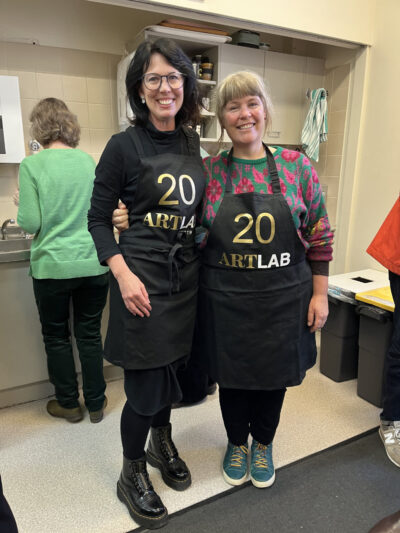
Jo Dawe and Jodie Scott in their 20-year Artlab aprons.
Treatments and Projects
Textiles
The textiles team has been busy with a few interesting projects since our last update. They have been assisting the Art Gallery of South Australia with the digitisation of its 19th-century dress collection. They have been altering contemporary-sized and shaped stock mannequins to fit the 19th-century silhouettes of the collection garments and preparing a range of standard ‘ready-to-stuff’ pads and underpinnings to have in a kit to make dressing and photographing the until-now-unphotographed collection as smooth as possible.
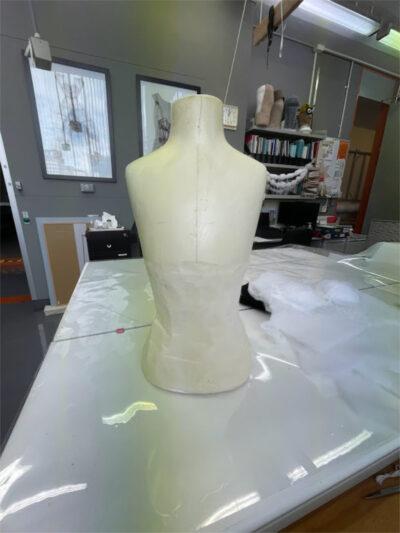
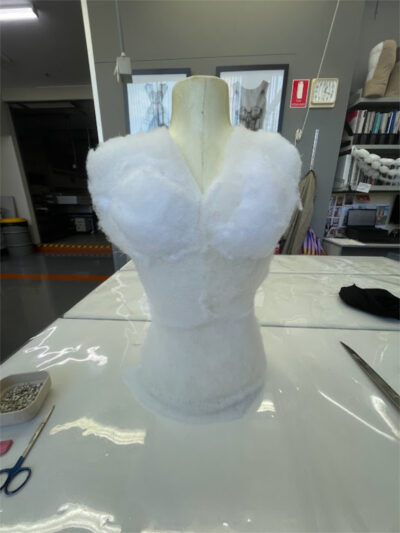
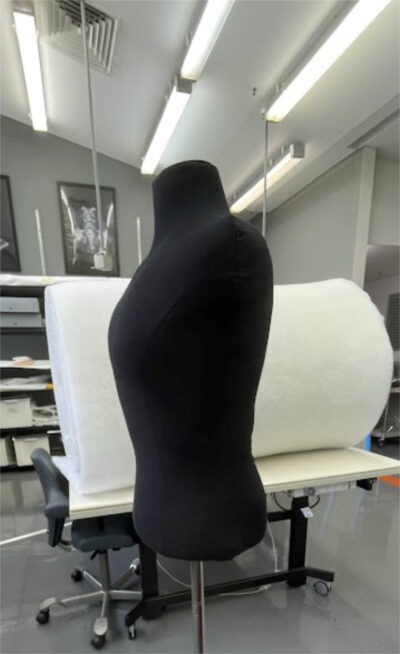
Modifying a foam child-sized form to fit a range of late 19th century dress silhouettes for the Art Gallery of South Australia’s dress digitisation project. Artlab Australia.
Kristin Phillips recently completed the treatment of a 15th century Indonesian batik cloth for the Art Gallery of South Australia. The treatment involved a full lining, which meant many hours of stitching (with some assistance from intern Freya Harrington, for which we thank her). The treatment also required loss compensation for areas of the missing design, for which Kristin cut away Beva-lined linen pieces to re-integrate the design and adhered these in place onto the lining. The treatment was extremely effective and allowed for its safe display in the gallery’s show Interwoven Journeys.
Victoria Thomas recently completed a treatment of the Central Australian Aboriginal Congress’s (CAAC) logo flag, which had been damaged by flooding. The treatment involved cleaning the heavily stained, two-sided flag to treat both mould staining and dye bleeding. The flag was washed in a series of buffered baths incorporating sodium percarbonate in low concentrations. The washes were followed with additional localised stain reduction using gel poultices for an overall effective treatment of the flag, which can be proudly displayed again by the Congress.
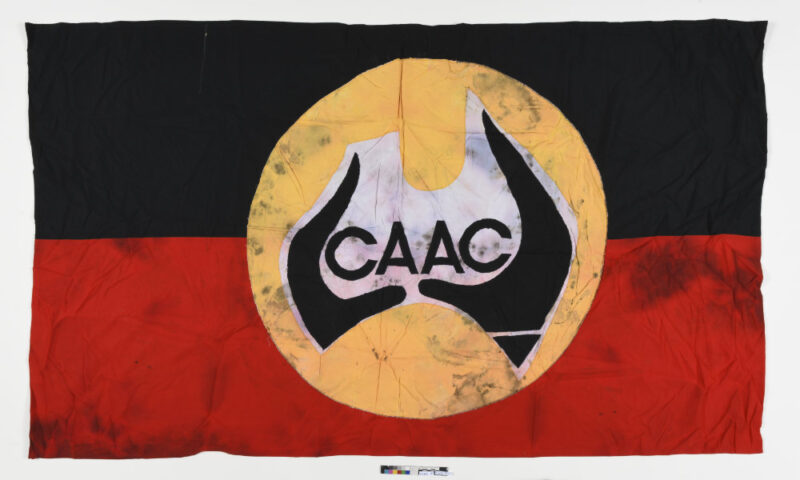
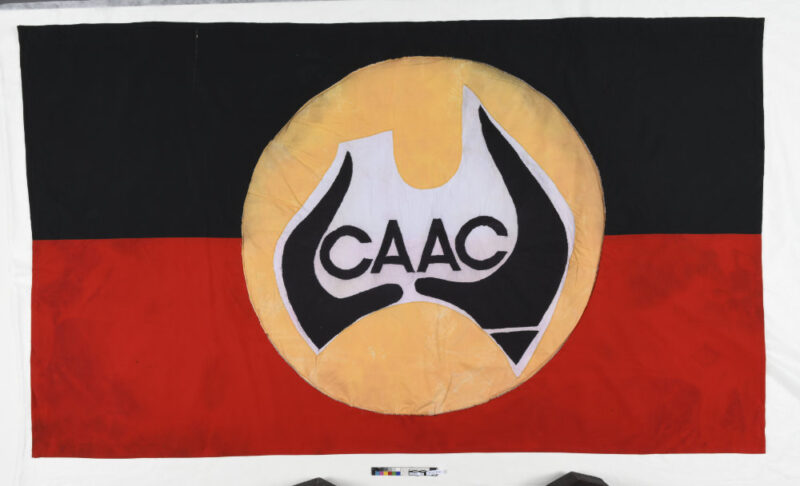
Before and after cleaning treatment of the Central Australian Aboriginal Congress flag. Artlab Australia.
Objects
A year ago, I (Sophie Parker) was diagnosed with breast cancer, and when you are sitting in the ‘hot seat’ you soon learn it is surprisingly common. There is a drug typically used in chemotherapy (Paclitaxel) that causes peripheral neuropathy in hands and feet in the majority of patients. This is nerve damage resulting in pins and needles, loss of sensation or complete numbness. It may last weeks or be permanent. I met several people who years later could no longer do yoga, couldn’t bush walk, and couldn’t feel their feet. This is very significant for conservators, affecting our dexterity and balance.
However, I did extensive research into reducing the effects of peripheral neuropathy. Overseas the use of cold mitts and boots is more commonly known in chemotherapy. Then, with good timing, there was a German research paper released last October that trialled compression versus chilling of hands and feet, both methods resulting in similar reduction of neuropathy. So I thought if I did compression and cold together, that would be doubly beneficial!
Just prior to the infusion, I constricted my fingers and toes with Micropore, and hands and feet with surgical gloves and compression bandages; then, additionally, and during infusion, I immersed my hands and feet in iced water. I will never know if I would have been affected without these measures, but I have no nerve damage. I did the whole course of chemo, as often people stop to mitigate the damage. For a few weeks after completion, I would occasionally get mildly ‘buzzy feet’ and slightly numb thumb tips.
If this is of interest to you or anyone you know, I would gladly share the details of what I did. My email
Grimwade Centre for Cultural Materials Conservation
For the Grimwade Centre for Cultural Materials Conservation, our global reach was busy. From 17 to 23 June, our master’s students joined the National Museum of the Philippines for Content in the Field in Manila. Working with the Fine Arts Division, we focused on exhibition preparations for a new regional museum in Cebu while our socialised and reflective learning centred on critical engagement of cross-cultural conservation work that takes place in the heritage sector. The experience was a powerful one for Grimwade Centre staff member Nicole Tse as the co-ordinator, and for students Cassandra Chan, Beatrice Dahllof, Sophie Fairbridge, Puneet Kaur, Weir Li, Jo Lean Lupgens, Jennie McKenzie, Ffion Olearczyk, Carra Reyes, Taryn Ryan, Merryn Stanger, and Eleanor Thomas. We thank Director Jeremy Barns, Deputy Director Jorell Legaspi, and the Fine Arts Division Officer in Charge Caroline Duque, Senior Researcher Arni Montemayor and staff for welcoming us.
Soon after, from 3 to 5 July we were in Bali for APTCCARN 6: Creative Conservation Initiatives, with Institut Konservasi and partners: Bali Cultural Preservation Office, Tampaksiring Presidential Palace & Tirta Empul Temple, Museum Puri Lukisan, Museum Pasifika, Cush Cush Gallery, and Museum Saka at Ayana Estate. With 80 participants from nine countries—Indonesia, Australia, UK, US, Thailand, Hong Kong, Malaysia, Singapore and Taiwan—the three days over seven sites generated dialogues and participation to reflect on heritage and sustainable conservation; why, whom and how tradition met modernity in the tropics; traditional and contemporary Balinese art; and collective creative initiatives, conservation practice and living heritage. Largely, these themes drew attention to why and what it means to maintain and care for material culture in the global south, with a focus on Bali, and notions of ‘heritage conservation’ in the geographies of former colonised people. We thank the APTCCARN6 organising committee of Nicole Tse, Saiful Bakhri, Lia Sumichan, Laila Fitrani, Diana Tay, and Seka Seneviratne, and importantly our local partner Institut Konservasi and all of the active participants. There is plenty more on APTCCARN 6 via Instagram @aptccarn_ and website APTCCARN 6 — Asia Pacific Tropical Climate Conservation Art Research Network and another piece on APTCCARN 6 by Eliza O’Donnell in this newsletter.
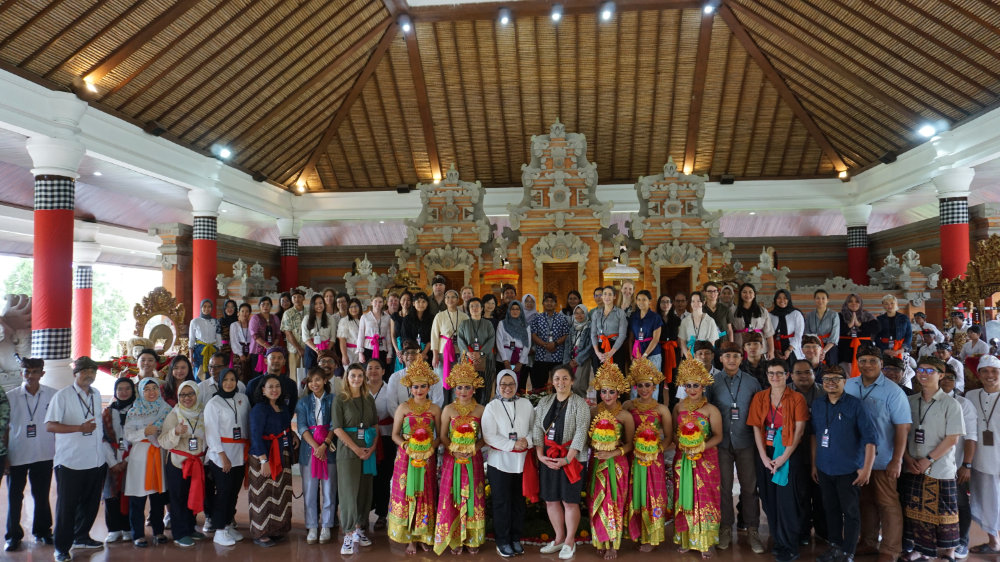
APTCCARN 6 participants at Tampaksiring Presidential Palace, Bali, 3–5 July 2023.
From 3 to 7 July, Nicole Tse also joined the University of Melbourne’s Faculty of Arts ‘Australia–Indonesia in Conversation’ with Universitas Gadjah Mada in Indonesia and the panel on ‘Socio-Cultural Activism and Arts for Change’. This was also a chance to meet up with UGM’s Dr Gea Parikesit, previous faculty of Arts Asia Fellow, and Dr Indraswari Kusumaningtyas, and to discuss guest teaching with UGM in 2024.
The Grimwade Centre was delighted to welcome Patrick Ravines as the Grimwade’s Faculty of Arts Indigenous Visiting Scholar for 2023. Patrick is Director and Professor, SUNY Buffalo State University – Patricia H. and Richard E. Garman Art Conservation Department. He directs the education of future conservators of cultural heritage and art. He is involved in justice, equity, diversity and inclusion with the local Black African American community and Seneca Nation to conserve their tangible heritage as a means to remember and heal by preserving the intangible stories within these objects. The main focus of Patrick’s research visit is to further develop and firmly establish relationships that were started virtually via Zoom during the COVID-19 pandemic.
The visit is the focus of a longer research project being conducted by Patrick Ravines and co-researchers Robyn Sloggett (Grimwade), Joe Stahlman (Seneca Nation), Gabriel Nodea (Gija) and other Australian Indigenous partners, combining theoretical, practical, cross cultural, socio-political and federal/governmental aspects in a trans collaborative research project between academic/university conservation education programs and Indigenous stakeholder communities.
During his visit Patrick joined the class for the Grimwade’s Master of Cultural Materials Conservation by Coursework oncountry subject Ngarranggarni Gija Art and Country at Warmun. Patrick delivered a public presentation on 12 July, outlining the history and current work being done as part of the developing partnership.
Grimwade Conservation Services
In July, Grimwade Conservation Services held a free public symposium exploring three of the most important early map collections in Australia and showcasing two large and complex conservation projects completed over nearly five years to conserve three rare and significant 17th century Dutch wall maps. Approximately 70 people attended the symposium, which featured presentations and lively discussions from historians and researchers formative in the development of the map collections of the National Library of Australia, the Kerry Stokes Collection, and MONA, discussing the history, significance, and motivation for these collections in the context of Australian mapping. Former and current GCS conservators outlined their recent award-winning journey to conserve two different copies of the rare and beautiful 17th-century wall map Archipelagus Orientalis, sive Asiaticus (Eastern and Asian archipelago) from the workshop of Master Cartographer for the Dutch East India Company Joan Blaeu and share the insights they gained into the materials and construction of these rare, beautiful, and complex maps. A recording of the complete symposium will be available shortly on the GCS website.
International Conservation Services (ICS) Melbourne
It is an exciting time at ICS Melbourne, with many large and varied projects in the works. The team is growing, with Toni Sampson joining as Senior Conservation Projects Manager. With a Master of Cultural Materials Conservation (Objects) from the University of Melbourne, Toni brings with her a valuable skill set, including previous experience working on heritage buildings, and a broad knowledge of materials, machinery, chemicals, paint mixing and colour matching from her many years working in hardware.
The ICS Melbourne team played an integral role in the conservation of the iconic Fitzroy Town Hall ceiling, which recently won an award for Heritage Conservation at the 2023 Victorian Architecture Awards. The beautiful elaborate plaster ceiling of Fitzroy Town Hall had deteriorated significantly, having sustained extensive water damage and mould contamination. Led by our Senior Conservation Manager Katie Smith, the team performed tear repairs and retouching.
Eden Christian and Zora Sanders undertook condition assessments and photogrammetric modelling on several scarred trees in north-west Melbourne to record their significance and safeguard those in areas of development. In addition, they conducted a very large collections storage assessment for one of Melbourne’s top universities, providing in-depth reporting and recommendations for improved storage.
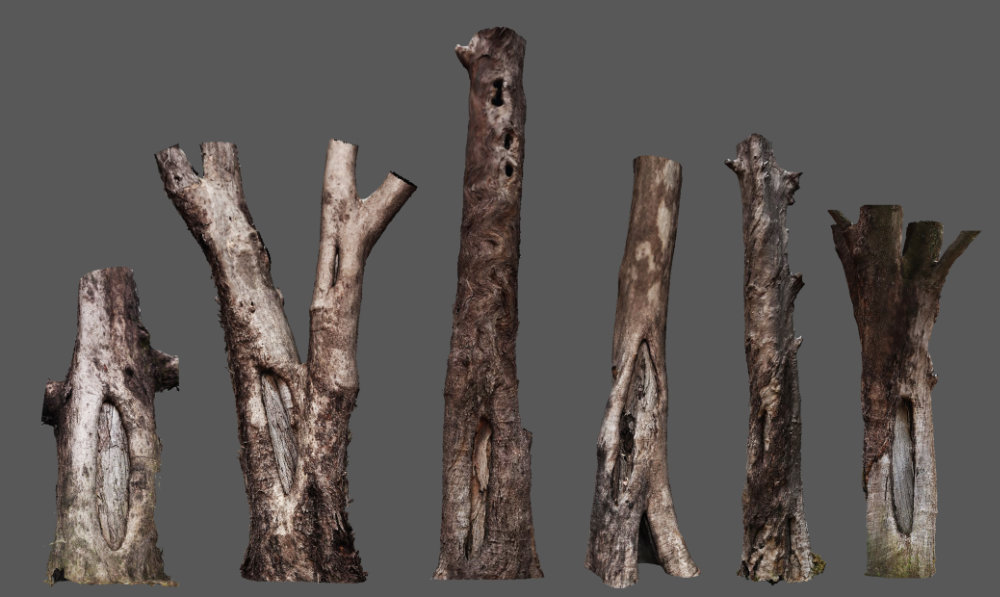
Scarred tree models.
Katie and Eden have recently taken on an exciting challenge at one of Melbourne’s most prominent theatres, collecting hundreds of paint samples and completing cross-sectional analyses to determine a colour scheme from the early 1900s.
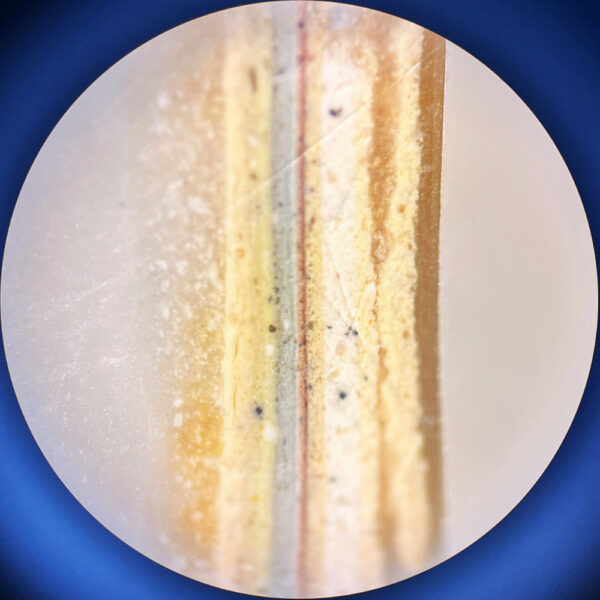
Cross-section of a paint sample for analysis.
Katie, Eden and Toni returned to the Fairies Tree in Fitzroy Gardens to conduct investigations into the structural integrity of the tree, as well as partially reintroducing a hollow in the tree that had previously been filled. The hollow was cleared out, inspected, partially re-filled, and re-painted to match the exterior. Our visits to the tree are always a pleasure as it is much-loved by the community and watching us maintain the fairies’ home is a point of fascination and joy for many children.
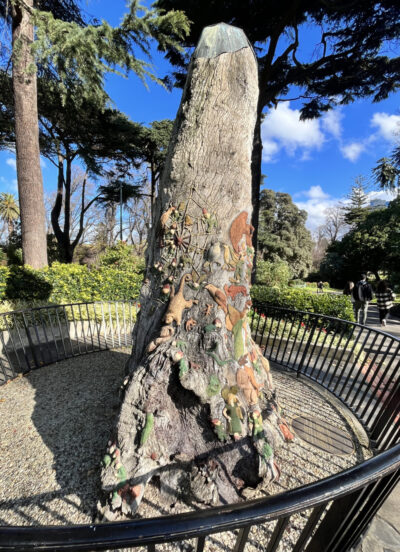
Fairies Tree after treatment.
The ICS Melbourne team, alongside TED Fine Art and JK Fasham, also worked on the massive undertaking of moving the marble statue of Hercules from his home at the Ballarat Botanical Gardens into our lab for treatment.
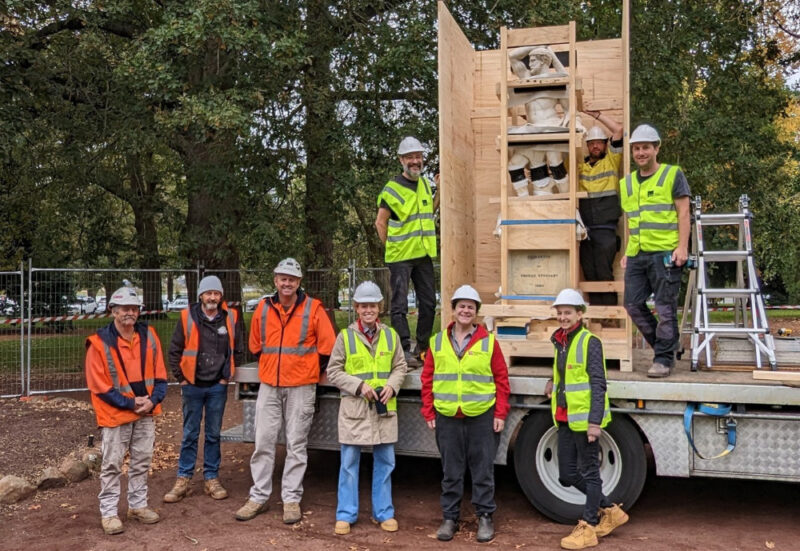
Katie Smith, Zora Sanders, Sarah Neaves, and teams from TED Fine Art and JK Fasham after the de-installation of Hercules.
National Gallery of Victoria (NGV)
General
Michael Varcoe-Cocks, Associate Director, Conservation, has been busy in his role on the steering committee of the design team for NGV-C. Michael and the team are also working closely with the Getty Conservation Institute (GCI) preparing for a four-day workshop to take place in August, co-hosted by the NGV and GCI, entitled Changing Climate Management Strategies, which will focus on addressing obstacles in developing and implementing more adaptive environmental management strategies in museums.
Conservation Project Assistant Manon Mikolaitis continues to assist with the auditing, collection management, and preservation planning of the NGV’s time-based media collection. As we approach the deinstallation of Melbourne Now, Manon has been documenting iteration reports for the time-based media works in this exhibition.
MaryJo Lelyveld, Manager, Conservation, recently attended a two-day symposium at Tate Modern as part of the Australian Research Council (ARC) funded project Precarious Movements: Choreography and the Museum, which looks at the presentation, acquisition, and preservation of performance art within the museum context.
MaryJo, along with the Exhibitions Conservation team of Catherine Earley, Janelle Borig, and Camielle Fitzmaurice, presented two one-day workshops on condition reporting of artworks for exhibition and loans, for members of the Public Galleries Association of Victoria (PGAV). These workshops provided a great opportunity for staff of regional and small metropolitan galleries to develop or refresh specialist skills and create peer-to-peer learning and professional networks.
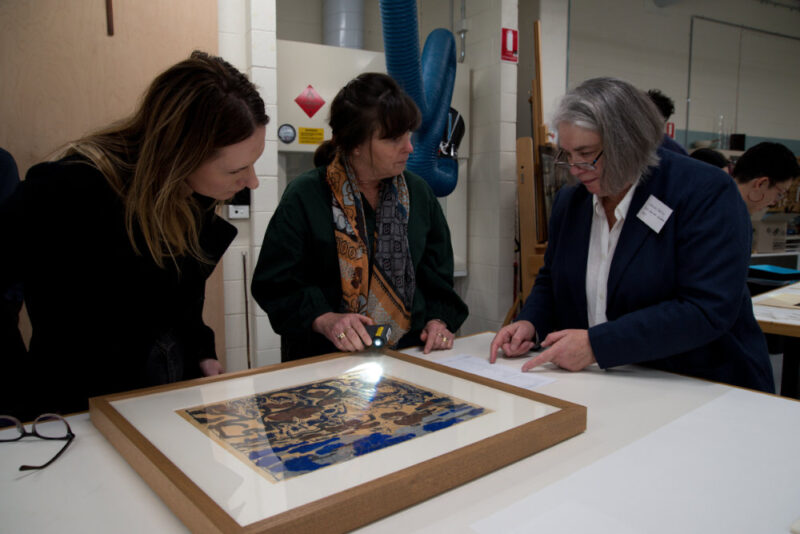
Catherine Earley provides guidance on assessing the condition of an artwork. Image: NGV Photographic Services.
We are also pleased to welcome Robyn McPherson to the team as Decorative Arts Conservation Fellow. The NGV was awarded a generous three-year grant from the Gidleigh Foundation to contribute to the conservation of the NGV’s decorative arts collection, as well as support decorative arts preservation practices across regional Victorian public collections.
Paintings
In the NGV paintings conservation studio, the team has been hard at work on a number of fronts. Caitlin Breare has been cleaning LS Lowry’s A man taken ill and has been part of the planning group for the upcoming workshop Changing Climate Management Strategies: Sustainable Collection Environments and Monitoring Object Response (August 7–10, 2023) co-organised by the Getty Conservation Institute and the National Gallery of Victoria. Raymonda Rajkowski has commenced the second of the major treatments on large circular canvases by Peter Upward and has gathered a group of large paintings for restretching, including works by Gerhard Richter, Timo Hogan and Jonas Balsaitis.
Raye Collins has been treating a group of paintings by Robert Rooney and Ralph Balson for upcoming exhibitions. Carl Villis has x-rayed dozens of paintings from the NGV’s 19th-century Salon gallery, which have become available for the first time in 20 years due to floor maintenance in the gallery. The list of paintings includes works by Edward Burne-Jones, Edwin Landseer, George Frederick Watts, Honoré Daumier, Camille Corot and Henry Gritten.
Frames and Furniture
NGV Framemaker Jason King undertook professional development working alongside David Butler in his studio in the Blue Mountains for a week, focusing on producing refined moulds from dental silicone impressions, pressing out and attaching complex composition ornament and more. A highlight at the end of the day was David’s hospitality and culinary extravaganzas.
Senior Conservator Holly McGowan-Jackson and Conservator Suzi Shaw have been working with Occupational Hygienist Sharann Johnson to review and develop our Hazardous Substances in Artworks procedures and delivering training to Conservation department staff and others from the Registration and Exhibitions & Collections Operations (Installation) teams. We appreciated the guidance from Museums Victoria as a benchmark for what we wanted to achieve. We also rented a mercury vapour analyser to check levels were within safe parameters in our display and storage areas. As expected, we found slightly elevated levels of mercury vapour when artworks such as mirrors, felted hats and carved cinnabar lacquer were stored in sealed containers like boxes or crates. Protocols around opening such storage boxes have been updated to reflect the potential risk of mercury vapour inhalation.
Paper and Photography
Over the last six months in preparation for the Rembrandt – True to Life exhibition, paper conservators Ruth Shervington, Louise Wilson and Bonnie Hearn have taken the opportunity to assess, examine and study 140 Rembrandt prints at the NGV. Ruth and Louise have focused on the study of Rembrandt’s paper and printmaking techniques respectively, and their essays can be read in the exhibition catalogue. Louise undertook aqueous conservation treatment of Rembrandt’s print Jan Cornelis Sylvius, preacher, 1646, using a conductivity and pH adjusted solution to successfully improve the integrity and strength of the paper. Bonnie captured newly found watermarks and collated over 30 years of research by NGV paper conservators into an online database Rembrandt’s watermarked papers at the National Gallery of Victoria: https://www.ngv.vic.gov.au/explore/collection/conservation/watermarks-rembrandt/
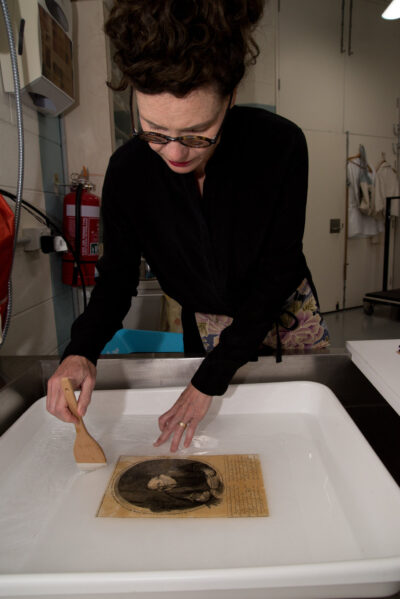
Louise Wilson immersion washing Rembrandt’s print Jan Cornelis Sylvius, preacher, currently on display in the Rembrandt – True to Life exhibition, until 10 September at NGVI. Image: NGV Photographic Services.
On 9 September 2023, NGV Conservation will hold a small event showcasing conservators’ work for Rembrandt’s prints, paintings and frames within the collection – save the date!
In October, NGVA will exhibit Real & Imagined, displaying the NGVs extensive collection of photographs, ranging from early daguerreotypes to fresh-off-the-press digital prints. For this exhibition, Ruth is currently revising a hanging system for the Patrick Pound artwork People who look dead but (probably) aren’t, 2011–2014, comprised of 187 small photographs. Ruth is also amid treatment of a silver gelatine photograph by Ruth Hollick, Thought, 1921, stabilising and retouching areas of loss. For the same exhibition, Bonnie is working closely with Design to display daguerreotypes, ambrotypes and photobooks.
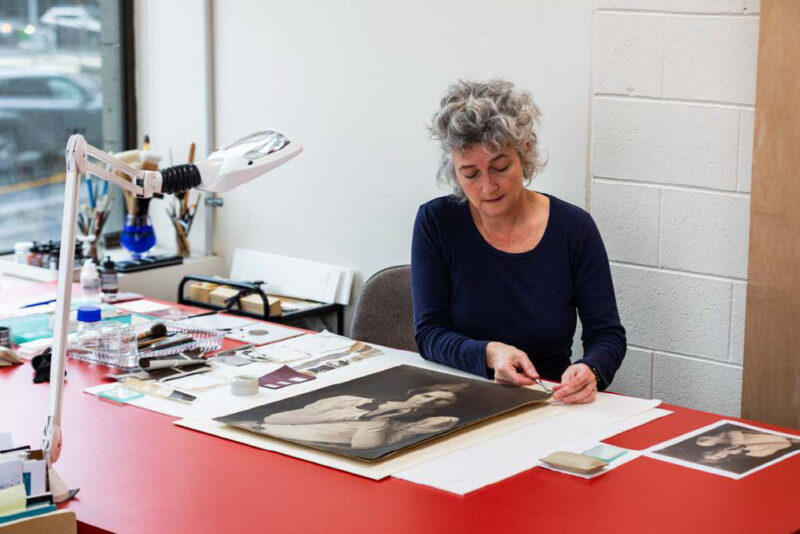
Ruth Shervington treating a silver gelatin photograph to be included in the exhibition Real & Imagined, opening in October 2023 at NGVA. Image: NGV Photographic Services.
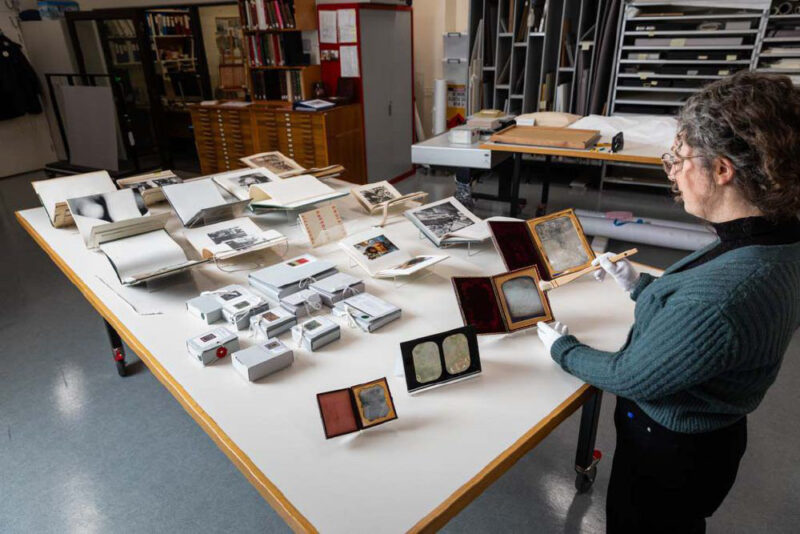
Bonnie Hearn preparing daguerreotypes, ambrotypes and photobooks for display in the exhibition Real & Imagined, opening in October 2023 at NGVA. Image: NGV Photographic Services.
Textiles
The Textiles Conservation team is excited to welcome Julia Spizzica to our ranks. Julia has taken up the position of Senior Textiles Display Specialist and is a graduate of the Victorian College of the Arts with a Bachelor of Production Design. She has a wealth of experience, as she has been working as a professional costume designer for almost a decade. The rest of the team—Skye Firth, Kate Douglas, and Bella Lipson-Smith—have been having some well-deserved annual leave after the de-installation of the Alexander McQueen: Mind Mythos Muse exhibition, and keeping busy with permanent collection changeovers, assessing many new acquisitions and planning for the upcoming triennial. Work has also progressed on the first of the Murdoch crewelwork bed hangings, with this long-term project approaching completion.
State Library Victoria
Collection Care
Social news
Earlier this year Collection Care changed its social media approach and is now publishing one blog per month. This allows us greater creative control and provides more content for the Brand and Audience Development team to draw on and repost. To date, this has included: A–Z of Collection Care (Parts 1 & 2), Reconstructing Brockhoff’s Biscuit Billboard (Parts 1 & 2), Baron Ferdinand von Mueller’s Educational Collections of Australian Plants, and Preserving the Saunders Family Archive.
Staff changes
Christine Mizzi recently took up the role of Paper Conservator, moving over from Preservation. Christine has been a valuable addition to the Conservation team, bringing significant skills to several long-term projects since starting in April.
Leah Williams started as Preventive Conservator in Preservation. This is a new position for the Library. Her main responsibilities include maintaining the environmental monitoring program, assisting with identification and treatment of ‘at risk’ photographic formats, and building on existing work relating to hazards in the collections.
In June, Collection Care also welcomed Fergus Patterson for a six-week internship as a part of his Master of Cultural Materials Conservation at the University of Melbourne.
Professional news
Conservation has purchased two new pieces of equipment. RH Conservation Engineering’s new infrared heat tool, which has been used with great success for pressure-sensitive adhesive tape removal. We also upgraded our Leica microscope camera to the Leica Flexicam C3. This has greatly improved its functionality, especially with a faster image refresh rate creating clearer images.
Conservation also has some handy tips and tricks to share. We are regularly asked to temporarily mount works on paper with a fast turnaround, for short public events. To streamline this process, Marika Kocsis, Senior Paper Conservator, suggested the use of galvanised fabric fasteners. After preparing a sheet of Foamcore slightly larger than the item, the fasteners are positioned strategically around the perimeter, hammered in-plane with the surface, and covered with Tyvek tape. The collection item is then placed over the top and secured with Mylar-interleaved magnets. At the end of the event, the fasteners can simply be removed and reused.
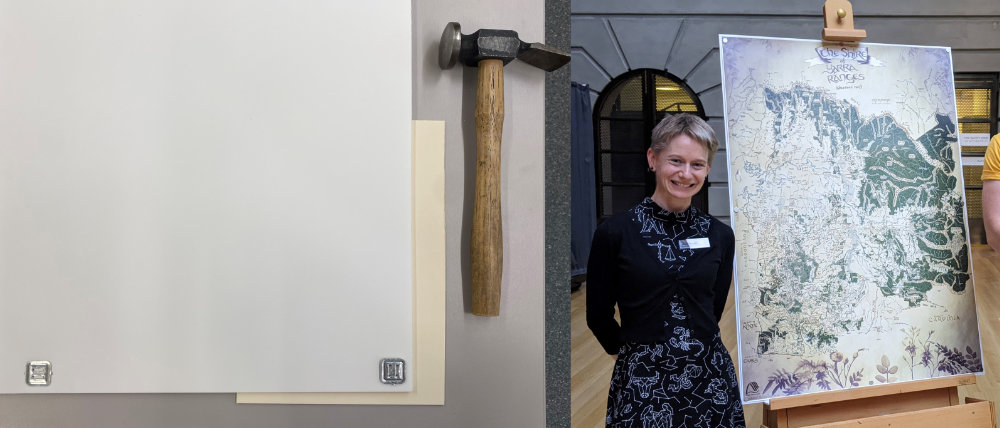
Left: Positioning galvanised fabric fasteners on a Foamcore support. Right: Senior Librarian Sarah Ryan with Adam Mattinson’s The Shire of Yarra Ranges Western half (MAPS 821.2 A 2022) showing the temporary mounting system. Image credits Albertine Hamilton and Phizz Telford.
Marika Kocsis also pioneered the use of another common domestic item: window flyscreens. When preparing to wash 11 rare and fragile issues of The Bendigo Star (RARENSL), we discovered that our oversized sink could accommodate two open newspapers at one time. A rigid support was required that could temporarily support the newspapers while washing and allow for adequate water circulation. Marika acquired two custom-made flyscreens, seen here in action.
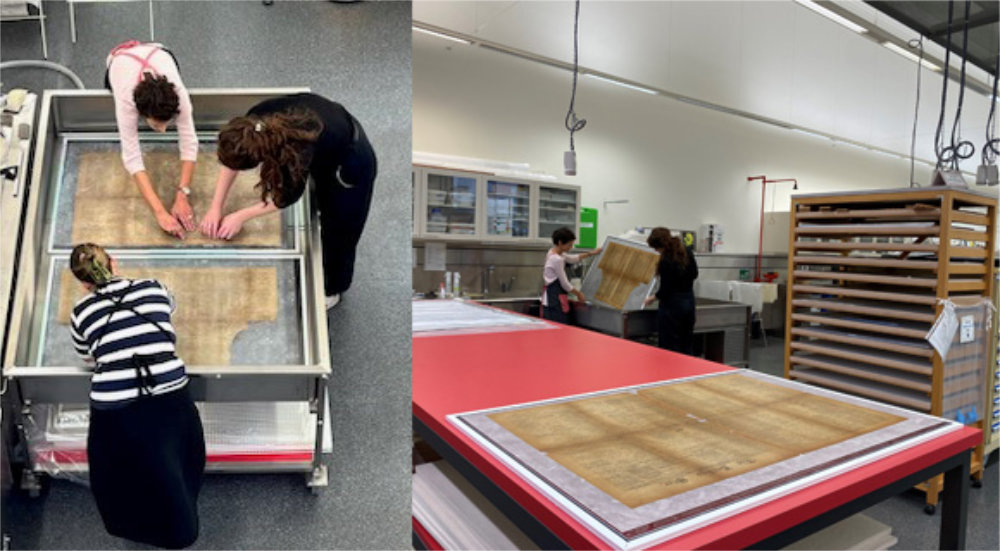
Washing two issues of The Bendigo Star newspaper (RARENSL). Image credits Marika Kocsis and Albertine Hamilton
Treatment projects
The Paper Conservation team has completed treatment of eight severely fragmented Blinky Bill advertising designs on tracing paper. Led by Paper Conservator Jessica McElhinney, this involved dyeing translucent paper for fills and testing various heat-set repair tissue recipes. We settled on 3:2:8 v/v Lascaux 498 HV, Lascaux 303 HV, and DI H2O.
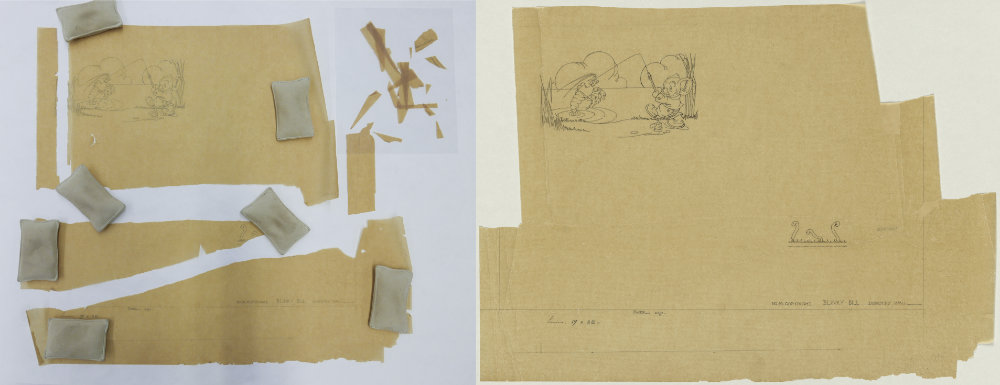
Blinky Bill advertising material (H2015.180/32), before and after treatment. Image credits Jessica McElhinney and Bart Geraedts.
Paper Conservation has reached the halfway point in the treatment of architectural plans by English architect William Butterfield. This collection includes 154 original drawings of St Paul’s Cathedral, Melbourne, dated between 1878 and1884. The largest plan to date was recently completed, taking 138 hours, and measuring 5200 x 2120 mm.
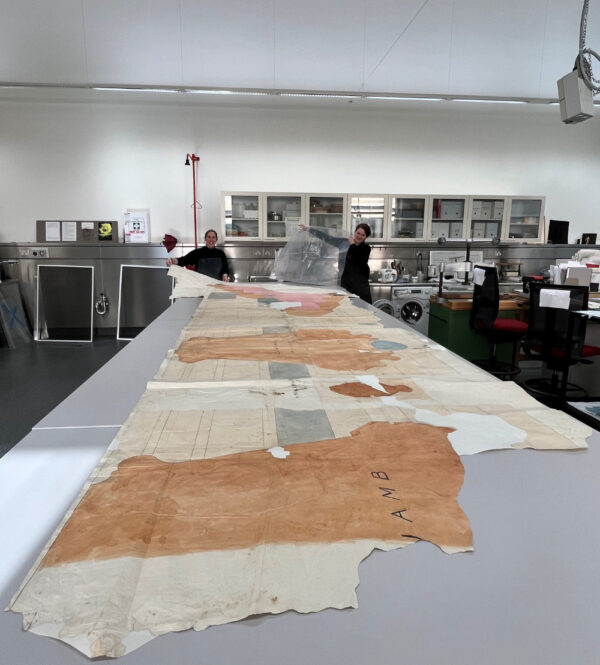
Celebrating completion of our largest Butterfield architectural plan to date (H2020.37/45). Image credit Marika Kocsis.
Book Conservator Helen McPherson completed an underback treatment of a folio size, 1611 edition of The Holy Bible (RARESEF 220.52 E11). The item had been rebound in a very thin reverse leather which was unable to withstand heavy use, leading to extensive damage. The treatment presented several technical and material challenges, including the size and weight of the volume.

The Holy Bible (RARESEF 220.52 E11), before and after treatment. Image credit Collection Access team, State Library Victoria.
Preservation is excited to share a big milestone in our Quarantine program, hitting our 2000th collection.
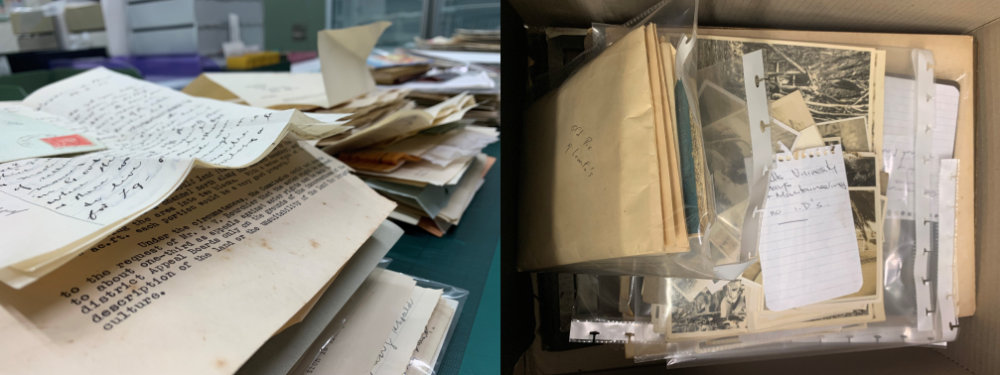
Treated (left) and untreated (right) uncatalogued collection material in Quarantine. Image credit Kate Holloway.
Starting in 2009 with a Pictures collection, we have assessed and treated a myriad of formats, shapes and sizes and levels of condition. Big shout out to Collection Care for a truly collegiate achievement.
Collections continues its journey through the rehousing process. Over 500 items were provided with a custom box in the last financial year and various photographic, paper and textile collections have been rehoused. Next on the list is a botanical collection created for research by Eileen Fisher (YMS 13701).
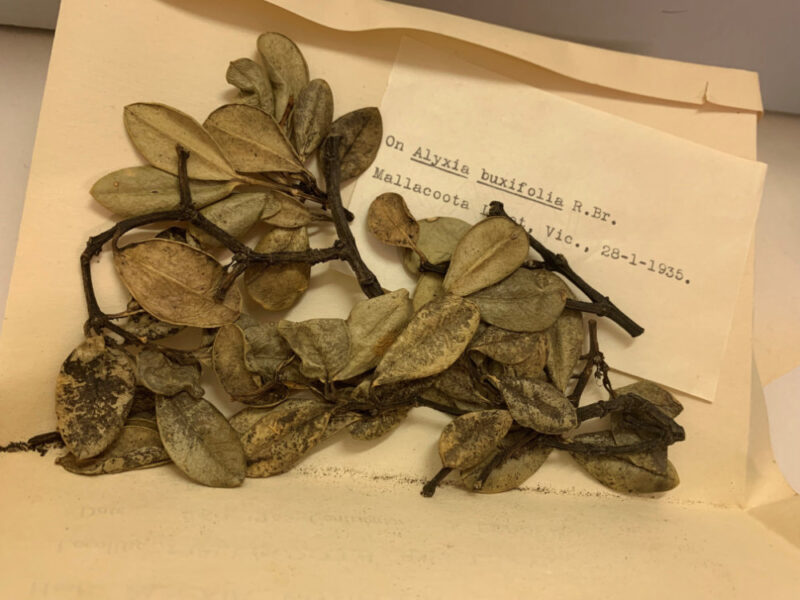
Botanical specimen from Records of Eileen Fisher (YMS 1370) awaiting rehousing. Image credit Kate Holloway.
Exhibitions
The Book Conservation team assisted with the installation of the latest iteration of World of the Book exhibition in March. This culminated in the of preparation of 322 books, flat works, and objects. This year features a display on Egyptology marking the 100th anniversary of the opening of Tutankhamun’s tomb. The highlight and biggest challenge for the book conservators were two magnificently large volumes of Description de l’Egypte by Edmé-François Jomard (RARESJF 913.32 J68).
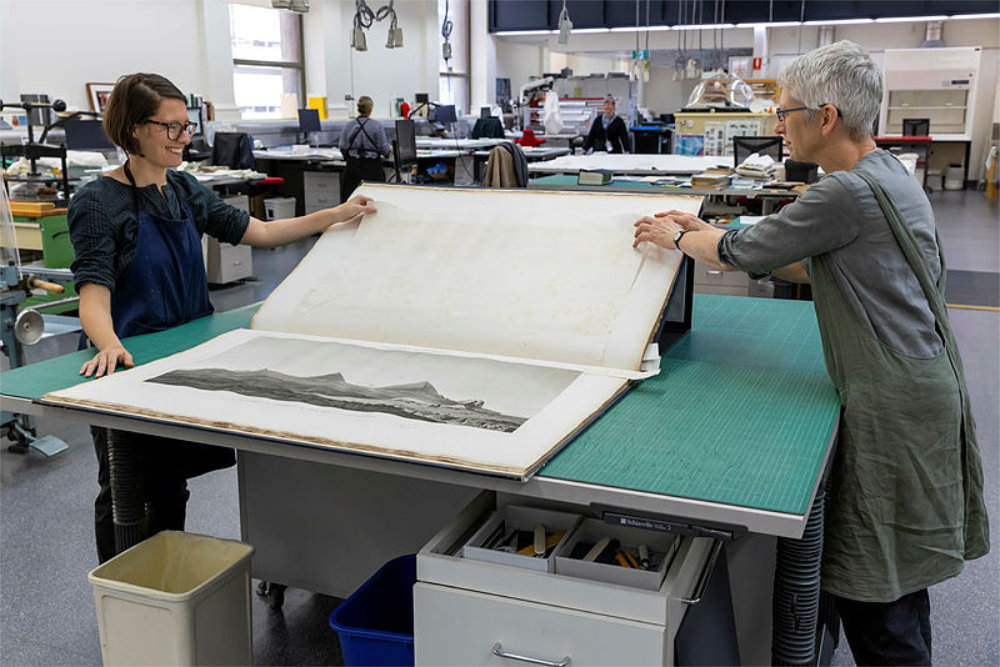
Preparing Description de l’Egypte (RARESJF 913.32 J68) for display. Image credit Jim Arneman.
Senior Book Conservator Katrina Ben assisted with the imaging of books for a digital-only exhibition, Beyond the Book: A journey through the Emmerson Collection. This exhibition will go live on 11 August with a series of public programs around the Emmerson Collection and the creation of the exhibition.
Handmade Universe came down in February. This included the deinstallation of Stargazing map (H2021.93/1-3), one of the most complex artworks displayed at the Library. The map is machine knitted with an 800plus LED array, circuit board driven by unique coding, operated via iPads. Before rolling onto a tube, custom padding prepared by textile specialist Catherine Shannon was placed over the artwork to help support the complex structure whilst in storage. It has since been crated and taken to Melbourne Museum for freezing before it is sent to off-site storage. Preservation Technician Jessye Wdowin-McGregor has been documenting all aspects of this time-based work, with future discussions planned with artist Sarah Spencer and the Library’s Digital Preservation Specialist on the preservation of the coding and circuit board that lights this work.
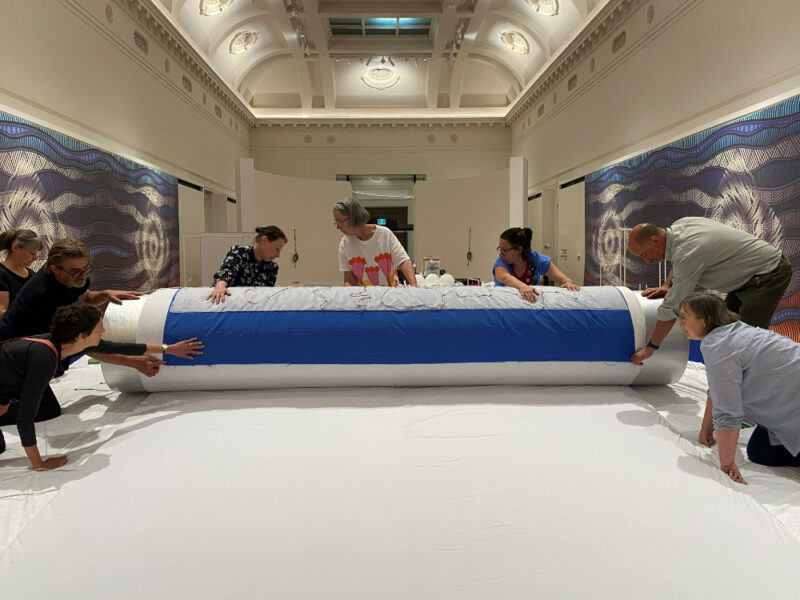
Rolling Sarah Spencer’s Stargazing map (H2021.93/1-3). Image credit Albertine Hamilton.
Conference attendance
Emily Keppel travelled to Sydney in June 2023 to undertake bookbinding training with internationally renowned bookbinders Michael Burke and Dominic Riley, completing three book models: a limp vellum binding, a library-style binding and a full (simplified) leather binding. See Emily’s workshop review elsewhere this newsletter.
Albertine Hamilton returned from a week-long residency at the Getty Center in March 2023, marking the completion of her participation in the Getty’s fully funded ‘Colour on Paper’ workshop. See Albertine’s workshop review elsewhere this newsletter.
International Conservation Services (ICS) Perth
ICS Perth had a busy lead-up to the end of June with assessments of a number of items of large technology heritage for the Revolutions Transport Museum, the Azelia Ley Homestead Museum and the WA Department of Fire and Emergency Services. Claire Rowson is also busy with the restoration of some gold-plated mayoral regalia and the metal surrounds from a historic ambrotype.
Ongoing works on murals and wall paintings across the Fremantle Prison UNESCO World Heritage-listed site have culminated for now. The ICS team returned in March to transfer a large mural in cell E51 from the back cell wall onto an auxiliary support. This will create a stand-alone artwork that can be stored or temporarily displayed elsewhere in the prison.
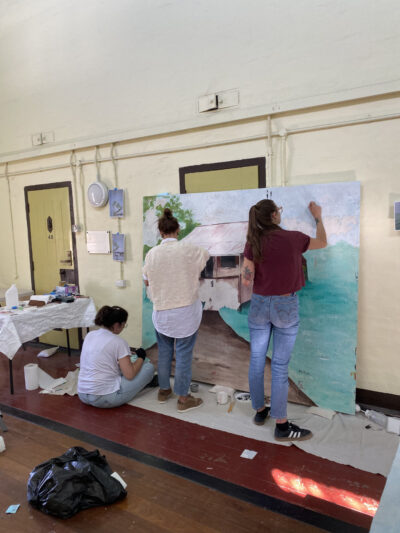
ICS Perth team retouching the Fremantle Prison mural.
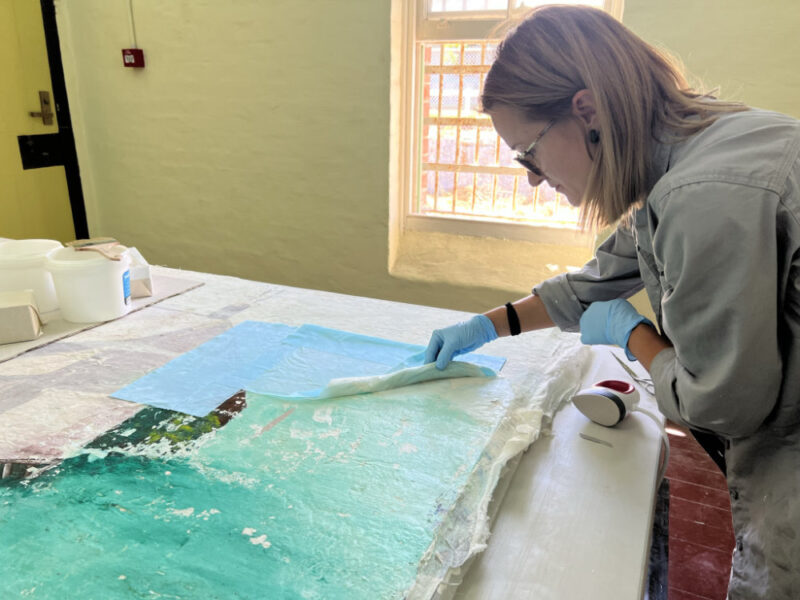
Principal Paintings & Murals Conservator Alis Jitarescue working on the support from the mural once removed from the cell wall.